Балтійська осінь. Частина 1. Латвія >>>
…за вікном автобуса промайнув стовпчик з символом Євросоюзу та написом «Estonia». В порівнянні з Латвією на перший погляд нічого не змінилось – все той же жовто-червого-зелений мішаний ліс, все ті ж маленькі села/хутори через які де-інде проглядається берег моря… Хоча, чим далі на північ, тим частіше автобус мчав повз населені пункти, що складались не лише з одноповерхових дерев’яних будинків – іноді бачив і так звані «селища міського типу» з трьох-, чотирьохповерховими целяними багатоквартирними. Напевне, виникли при фабриках чи інших важливих об’єктах. Була одна зупинка – та й та для посадки/висадки пасажирів – у місті Пярну. Цілісного уявлення про головний курорт Естонії скласти не вдалося – та ж сама одноповерхова приватна забудова, невеличкі парки. Ось на горизонті вже з’явились талліннські передмістя. В’їхали в місто через ліс, через новий район.
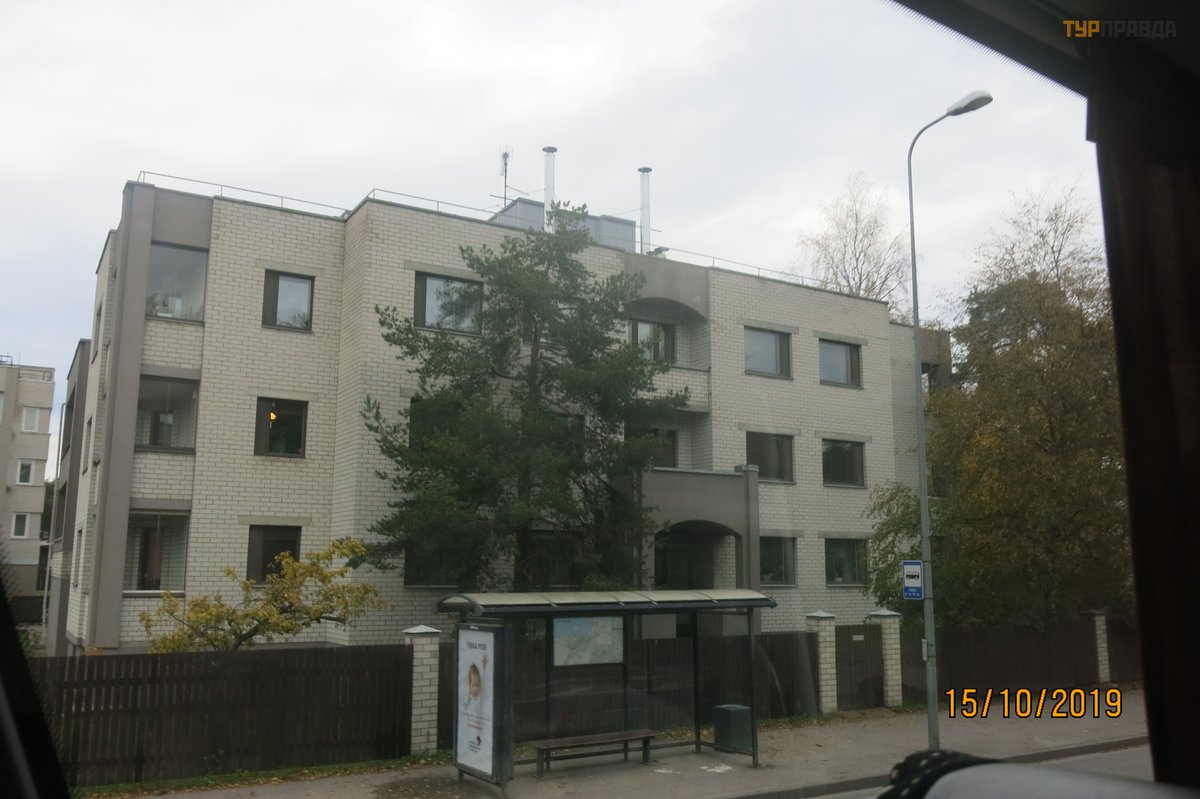
Звернув увагу, що на в’їзді в місті були 2 невеликі торгівельні центри (майже як у нас). Перші враження – в місті багато транспортних розв’язок, причому не дуже зручних, друга – як тільки виїхали з лісу в місто на рівнину, то одразу стало видно історичний центр на пагорбі Тоомпеаа. Будинки в середмісті трьох-, чотирьохповерхові, з біло-сірої цегли, не нові (орієнтовно 1950-1960 роки), проте гарно збереглися. Нарешті, кінцева – автовокзал (естонською Bussijaam). Одразу ж на платформі розташовано T-kiosk, в якому серед іншого продаються квитки на міський транспорт. Купую e-CARD (2 євро заставна вартість) та кладу на карту 10 євро. Кошти на картці використовувати для оплати проїзду, вартість поїздки по картці €1,10, тривалість поїздки 60 хвилин, можливі пересадки. На трамваї №2 їдемо до нашого готелю. Виходимо на 5-й зупинці («Linnahall»), орієнтир – Морські ворота та башта «Товста Маргарита» і прямуємо до нашого готелю на набережній.
Я вдруге приїхав в Таллінн (вперше – в серпні 2012, розповідь тут) і район не впізнав. Сім років тому тут були старовинні одно-, двохповерхові (місцями навіть дерев’яні) будинки, зараз на їх місці або вже побудовані офісні центри зі скла і бетону, або будівництво ще триває. Готель наш називається «Tallink Express Hotel» (263 євро/5 ночей/твін), у 2012 був cусідій, але розташованій в тій же самій будівлі "Tallink SPA & Conference Hotel". Готелем повністю задоволені (тихо, дуже гарний сніданок, чудове розташування – 15 хвилин до Терміналу А морського порту, 10 хвилин до історичного центру, 5 хвилин до зупинки автобусу в аеропорт, 20 хвилин до залізничного вокзалу).
Поки поселились – вже сутеніє, в центр йти вже пізно, вирішуємо відвідати магазин «Rimi», який по пам’яті знаходився на іншому березі Адміралтейської затоки (по факту – марини для яхт та старовинного буксиру). Магазин знайшли не одразу (за останні 7 років на протилежному березі затоки побудували 3 великі мережеві готелі. Та й сам «Rimi» зазнав змін – тепер він знаходиться в середині великого торгівельного центру «Nautica Keskus», в якому представлені магазини багатьох відомих брендів на зразок H&M, New Yorker, Deichmann тощо. Після невеликого шопінгу повертаємось в готель.
Наступного дня після сніданку вирушаємо у Старе місто. Входимо через Морські ворота по вулиці Pikk.
 Морські ворота. Ліворуч – "Товста Маргарита"
Морські ворота. Ліворуч – "Товста Маргарита"
Ранок. Тихо і майже безлюдно. Церква Св. Олафа (Oleviste) вся в риштуваннях, тому, ймовірно, зачинена.

В наступному кварталі вирізняється архітектурний ансамбль «Три сестри» (там розміщено дуже дорогий готель).
 "Три сестри"
"Три сестри"
Пр вулицях Pagari і Suurtuki виходимо до Кріпосної стіни (теж пам’ятка Талліна), під самою стіною проходить вулиця Laboratorium, де у будинку №22 знаходиться Український культурний центр та Українська Греко-Католицька Церква.
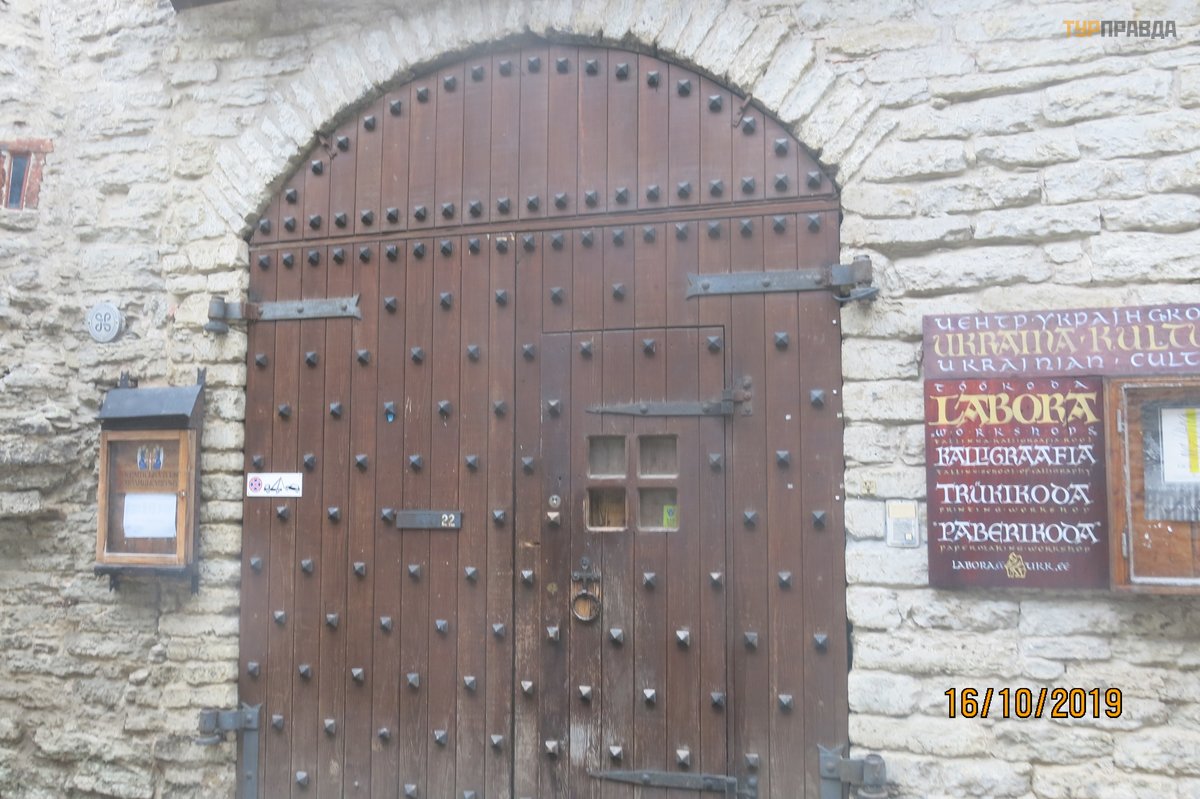 УГКЦ в Таллінні
УГКЦ в Таллінні

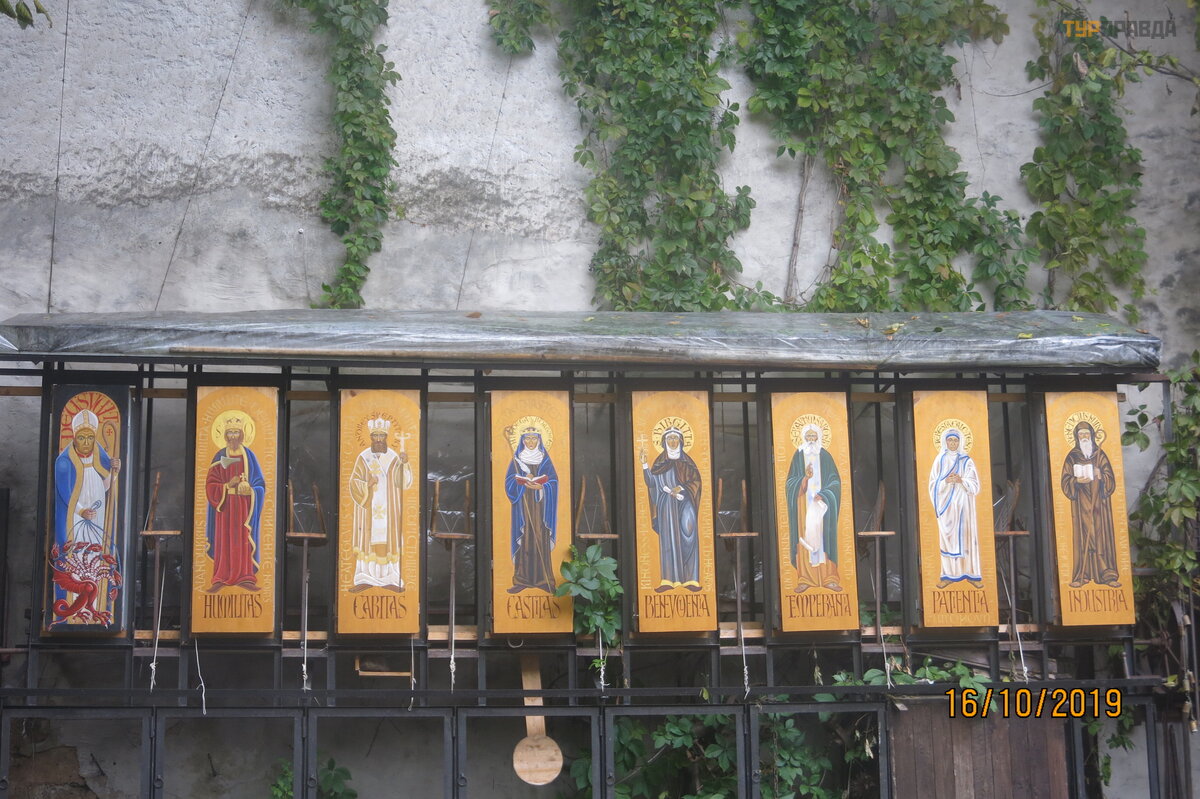
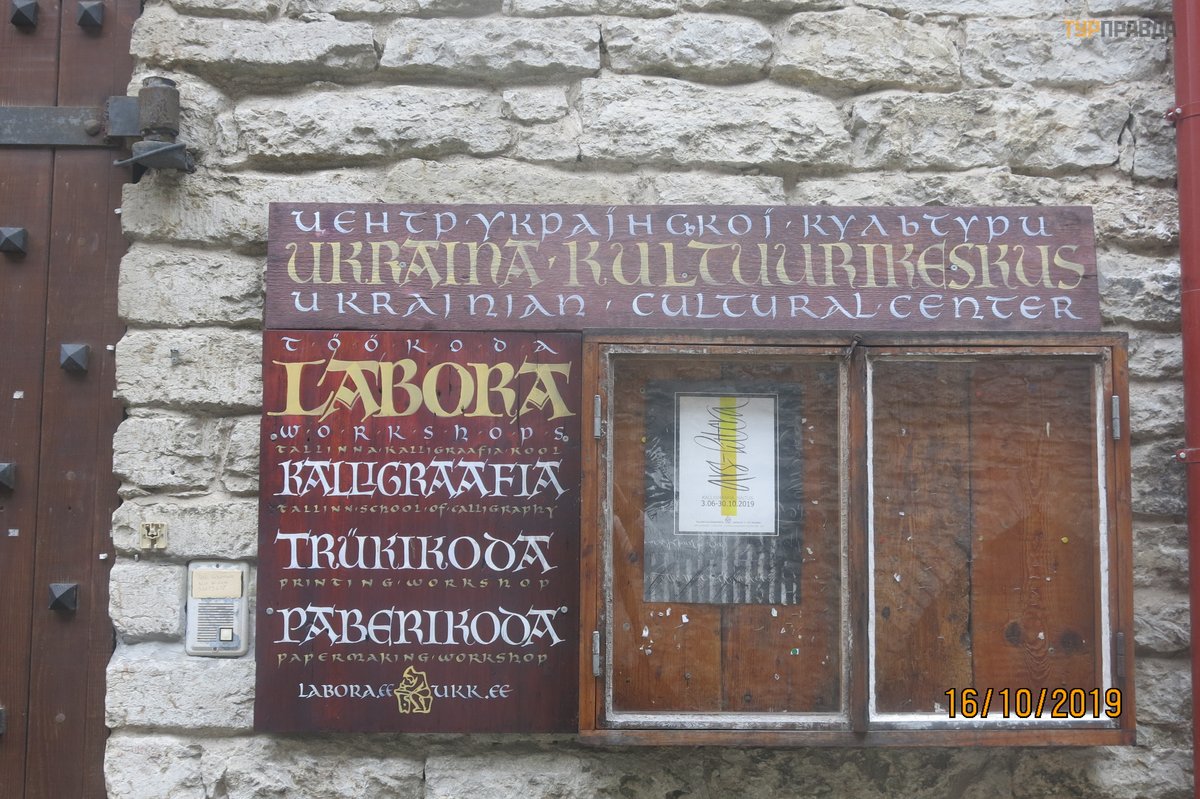
Церква знаходиться у дворі і в той час була зачинена (служба того дня – лише вечірня). По вулиці Lai мимо старовинної будівлі театру наближаємося до Ратушної площі. Звернув увагу, що на будинках під дахом знаходяться гаки (голандський стиль), на який кріпилися троси, по яких втягувалися вантажі на верхні поверхи (східці у середньовічних будинках вузькі та круті).

Після площі Roheline Turg починається «відреставрований шик» – старі будинки в стилі арт-нуво сучасній реновації, багато дипломатичних місій, театр, будинок гільдії Св. Кнудта, зараз там знаходиться театральне училище.

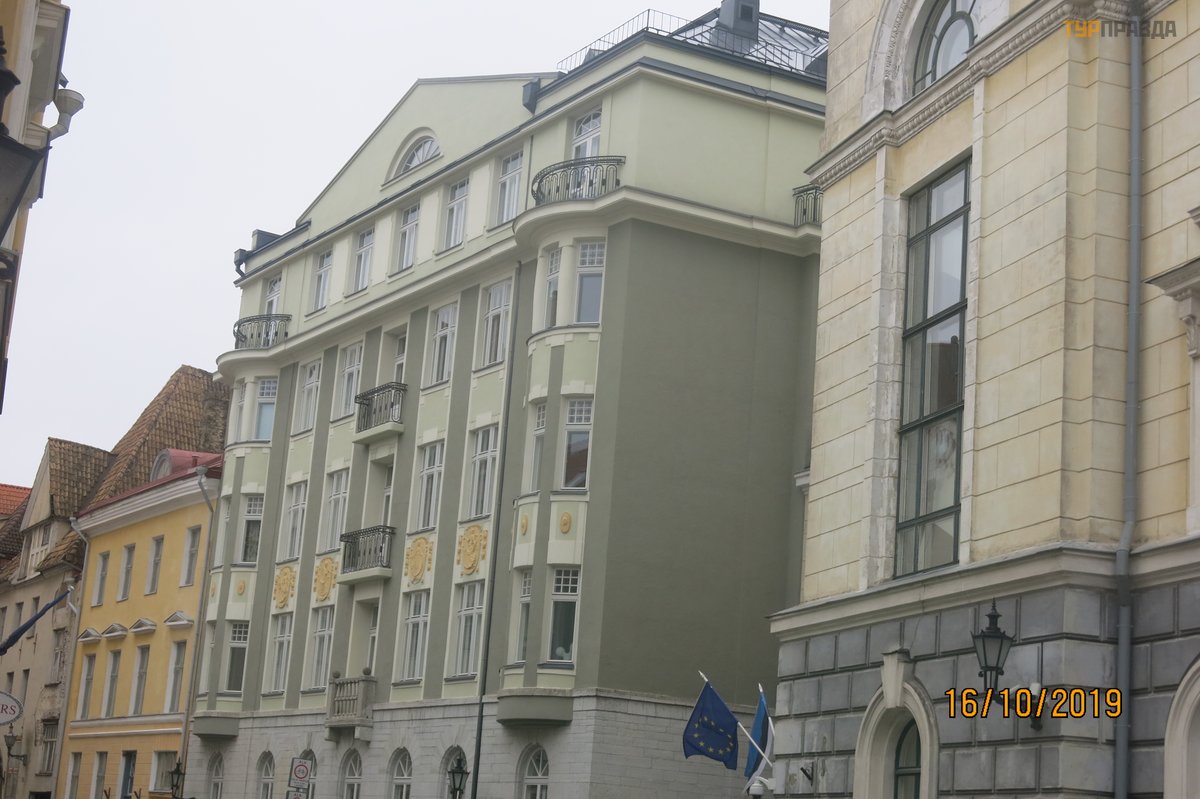
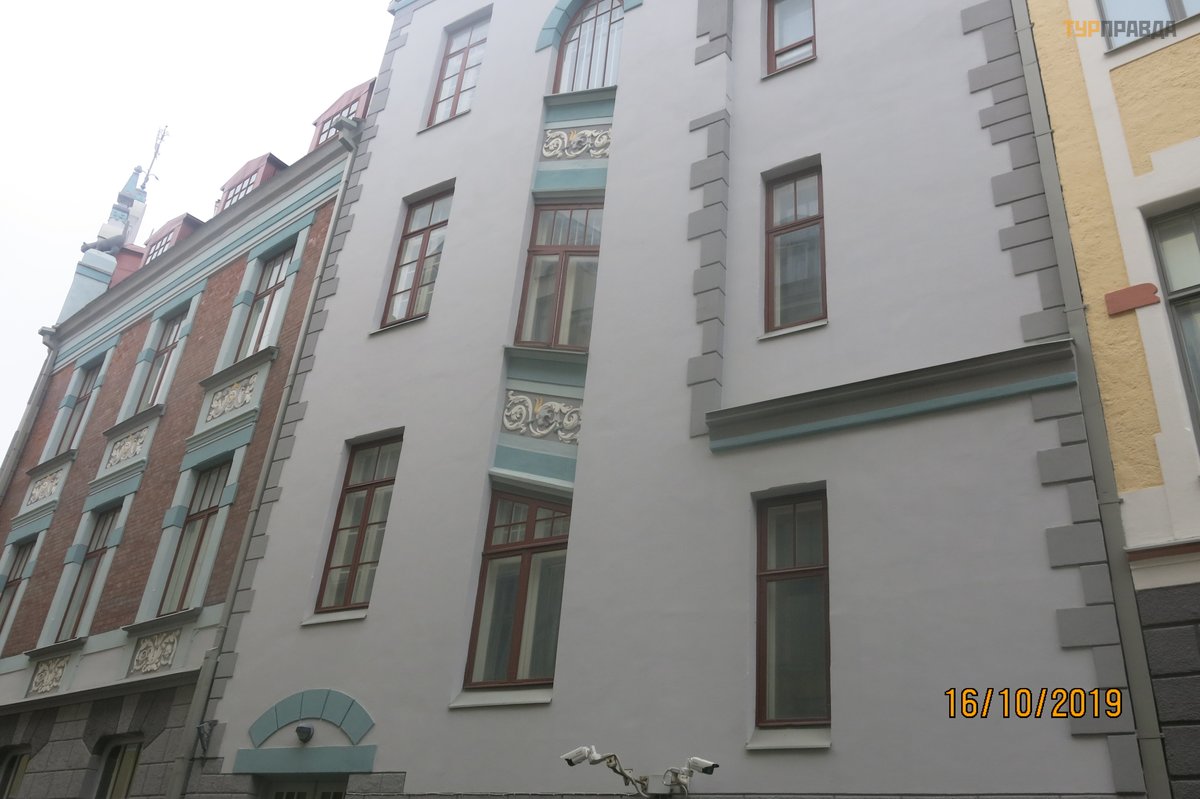



Про «український слід» інформації немає.
Поруч – відомий «будинок біля дракона» (класика Талінського модерну).
Поступово спускаємось до Ратушної площі. Ось і старовинна Ратуша Талліна із неофіційним символом міста – Старим Томасом (флюгером у вигляді лицаря з довгими вусами). Зробивши фотосесію на площі, вирушаємо у Верхнє місто (безпосередньо сам замок Тоомпеаа), спочатку по вул. Данкрі, ненадовго звернувши до Церкви Св. Миколая (Niguliste) – зараз там музей церковного мистецтва, вхід платний – €8.
 Церква Св. Миколая (Niguliste)
Церква Св. Миколая (Niguliste)
Здійснивши досить крутий підйом по східцях вулиці Люхіге-Ялг, виходимо безпосередньо у «Сад Данського короля» – невеличкий парк під кріпосною стіною, на якій розміщено дерев’яну галерею, дуже атмосферну. У відреставрованій башті Neitsitorn (виявляться, є ні багато, ні мало об’єктом Всесвітньої Спадщини ЮНЕСКО) розміщено одну з експозиції музею історії Талліна.
 Башта "Neitsitorn"
Башта "Neitsitorn"
Цей парк є пам’яткою про 100-річне правління Данії в Талліні. Антураж середньовіччя доповнюють металеві статуї трьох монахів-францисканців та старовинна гармата.
 "Сад Данського Короля"
"Сад Данського Короля"
Також звідти відкриваються гарні види на нижнє місто.
Через середньовічні ворота виходимо у Верхнє місто, що фактично знаходиться у складі Таллінського замку. Домінантою Верхнього міста є 46-метрова башта Довгий Герман (побудована в 1370-му році), на щоглі якої майорить прапор Естонії, який піднімають щодня на сході Сонця і спускають на заході Сонця.
 "Довгий Герман"
"Довгий Герман"
До башти прибудовано величний будинковий комплекс XVIII ст., в якому розміщено Рійгікогу – парламент Естонії.
 Парламент Естонії
Парламент Естонії
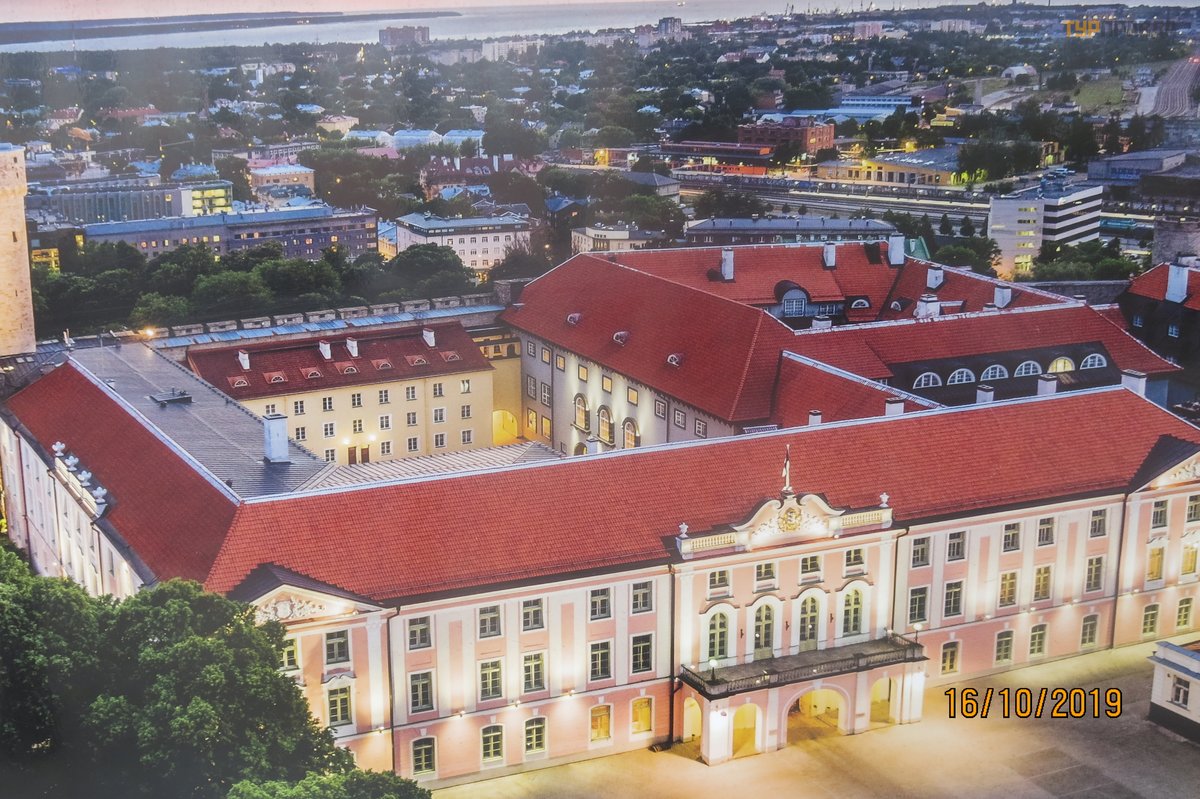
Поруч з парламентом знаходиться невеликий парк із розарієм та неодмінними лавочками. Майже навпроти, якщо йти по вулиці Toom-Koli середньовічна будівля Головпоштамту, а ще далі – Кафедральний (Домський) Собор. Зовні, як із середини, дуже аскетичний. Вхід 3 євро.
 В Домському Соборі
В Домському Соборі
У другій половині дня, між богослужіннями, в соборі проводяться концерти органної музики. За Домською площею повертаємо на вулицю Rahukohtu, яка закінчується оглядовим майданчиком, двома великими сувенірними магазинами (з широким вибором виробів з бурштину)...
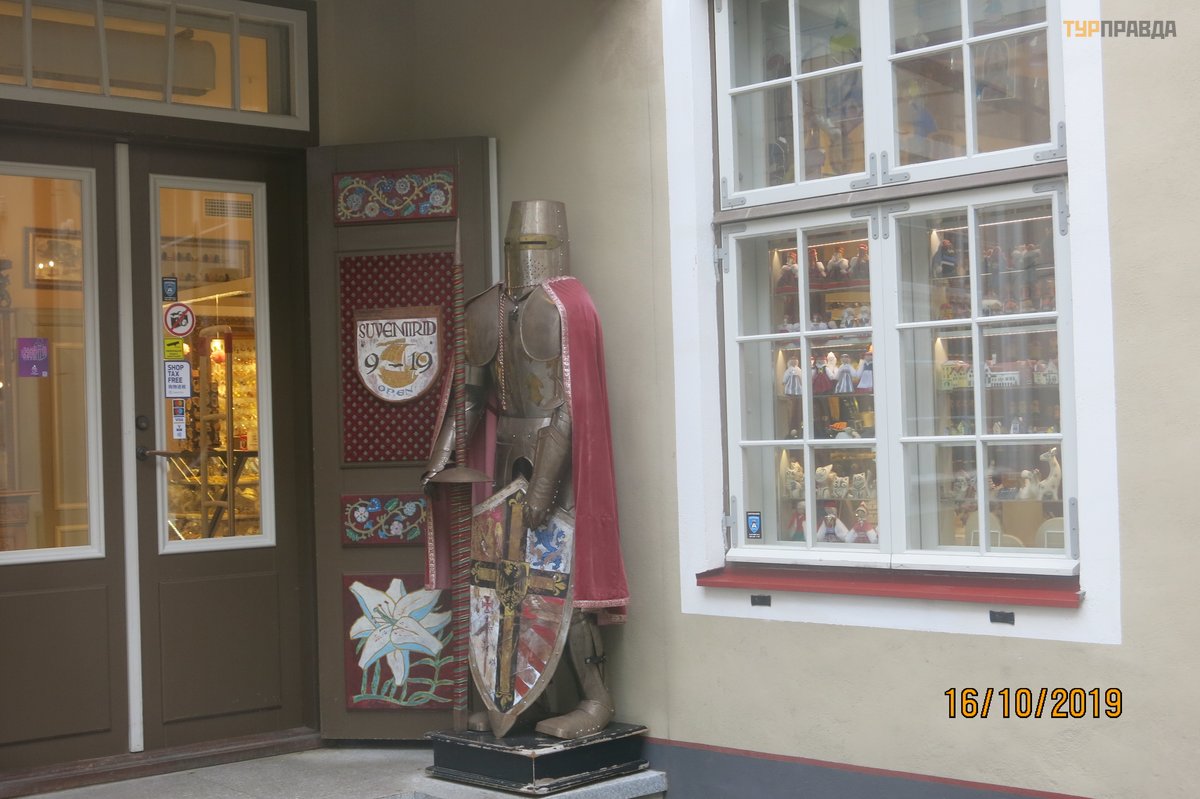
...та будівлею Кабінету міністрів Естонії.
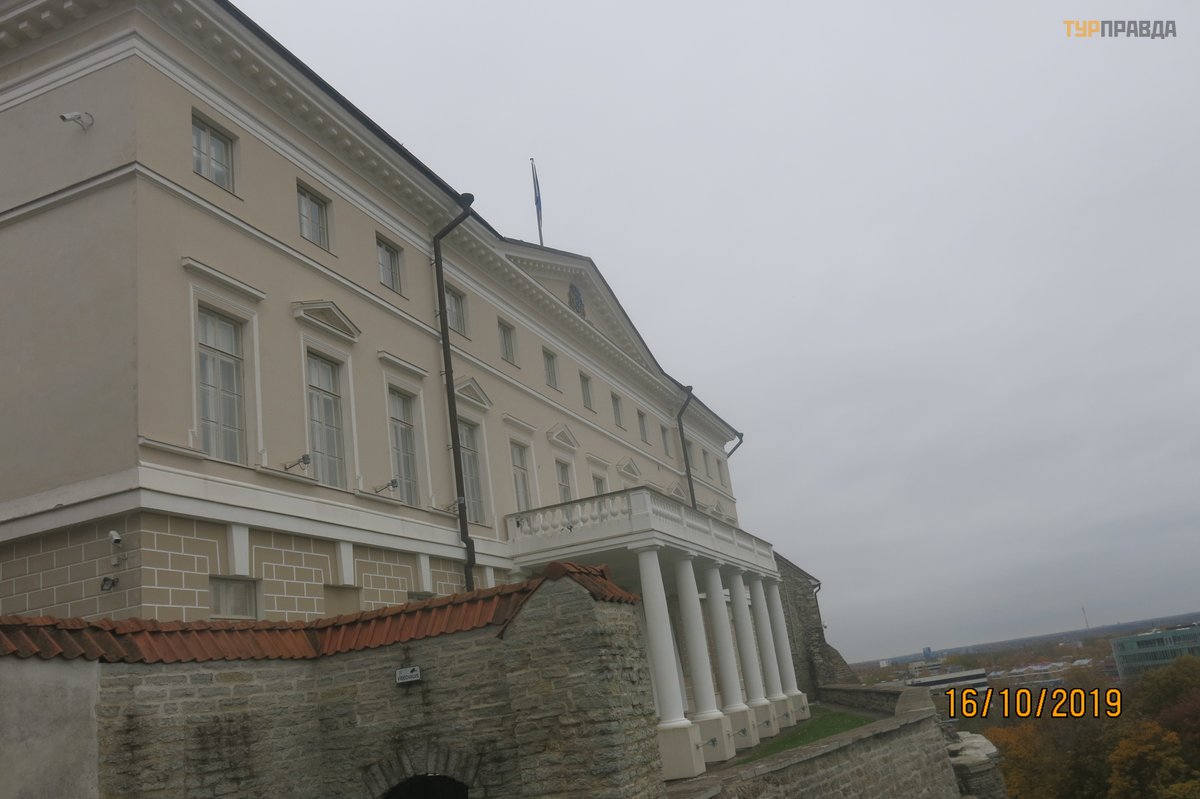
Після фотосесії з видами на морський порт, залізничний вокзал, старі квартали та сучасні райони (кожен обирає, види, які йому до душі)...

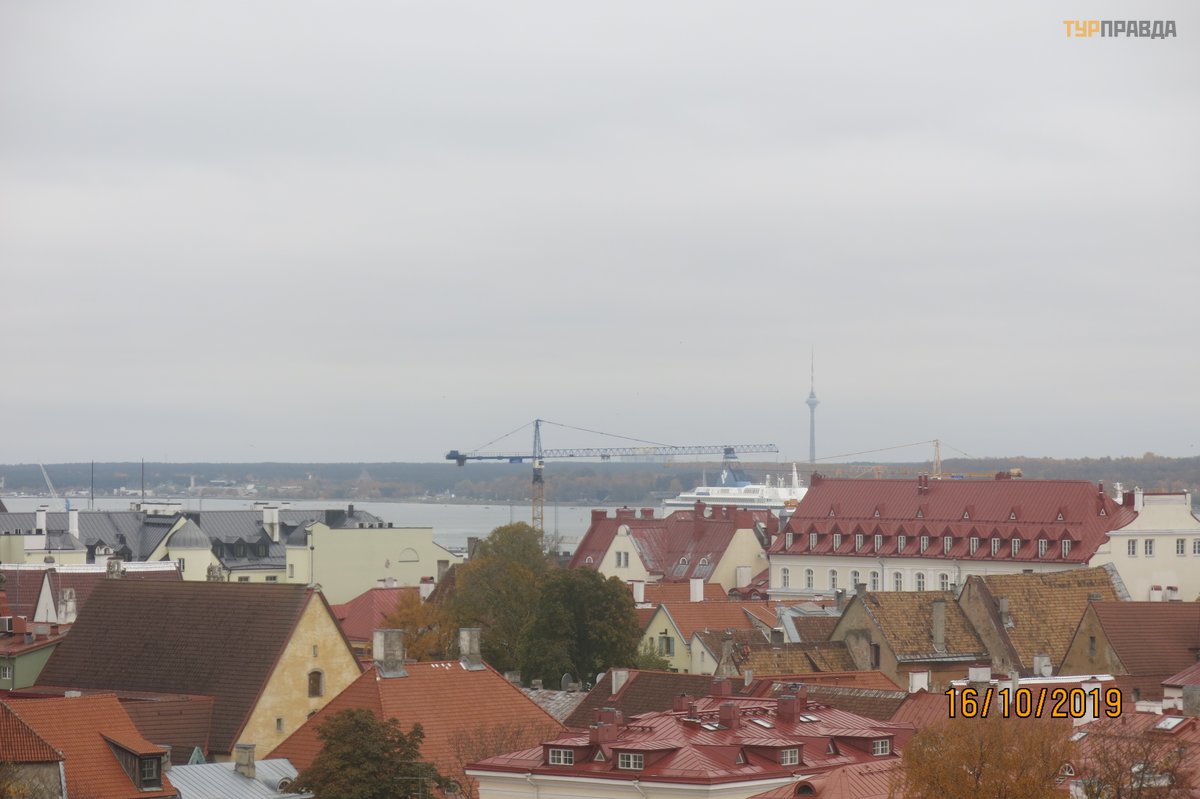

...та шопінгу, знову повертаємо до центру. На шляху – також фотографуємося на найвужчій вулиці Талліна (перший поворот ліворуч від Rahukohtu, якщо йти до центру). У Нижнє місто спускаємося по вулиці Пікк-Ялг, не такій крутій, як Люхіге-Ялг, але більш довгій (місцеві мешканці називають Пікк-Ялг «довга нога», а Люхіге-Ялг – «коротка нога»). З Нижнього міста знов через Ратушну площу через ворота Viru (та розташованого поруч квіткового ринку), виходимо на проспект Viru, першою будівлею на якому є 23-поверховий готель Viru, перші 6 поверхів якого займає сучасний універмаг Viru Keskes (побудований у 1984 році). Магазинів та бутиків в універмазі понад 100, кафе небагато, але всі вони чомусь з ресторанними цінами та претензіями на високу кухню.
Цікава історія з WC. У Viru Keskes вони платні (0,2 євро однією монетою), доступ організовано через турнікет. Для тих, хто не має монети вказаного номіналу, встановлено автомат для розміну. Автомат розмінює монети 1, 2 євро та купюру 5 євро.
Асортимент та ціни в кафе в універмазі не вразили, то вирішили пообідати навпроти – в одному з кафе в кварталі «Роттерман».
Квартал «Роттерман» – це історичний район навпроти порту (побудовано в другій половині 19 ст.). Він являв собою промзону ізпортоіими складами та невеличким заводом по виробництву будівельних матеріалів із знаменитою димовою трубою. У другій половині ХХ ст. виробництва були закриті, а район деякий час перебував у занепаді. У історію кінематографу він увійшов як місце зйомки фантастично-філософського фільму «Сталкер». У 2000-х рр. будівлі кварталу було частково знесено (але димову трубу залишено для історії), а ті, що залишились, переобладнали під сучасні офіси, мистецькі галереї, кафе, магазини.
Обідали в мережевому кафе «VAPIANO» (доводилося відвідувати заклади цієї мережі в Німеччині), 16 євро на двох, цілком пристойно. Трохи здувивало, що частина персоналу – відверто індо-пакистанської зовнішності (до того, вихідців з Азії в Латвії та Естонії, нетуристів, взагалі не бачив). Напевне, приїхали в Таллін в рамках внутрішньо корпоративної релокації.
Після обіду вирішуємо продовжити тему шопінгу. Для цього відправляємося в ТЦ "Prisma" (пам’ятаю його ще по поїздці 2012 року), їдемо автобусом №17. Цікавий нюанс по спобу оплати: при оплаті проїзду з E-card, на день списується лише 3 поїздки (це я з’ясував вже після повернення), як бути якщо в день користуєшся міським транспортом 4 рази та більше – не зрозуміло. Контролерів у міському транспорті не бачив жодного разу. Їхати недовго, приблизно хвилин 15.
За минулі 7 років (з часу мого попереднього відвідування) ТЦ «Prisma» дуже змінився – до нього прибудували інший ТЦ («Kristina») значно більший за розмірами. Це вже не центр, район навколо типові 4-5 поверхові будинки (орієнтовно 1953-1963 років), але дуже доглянуті, без креативно засклених балконів та супутникових антен, нещодавно реставровані.

ТЦ «Prisma- Kristina» вразив не тільки розмірами, а й асортиментом, крім широковідомих транснаціональних брендів, чимало також місцевих марок, а також марок країн Скандинавії. Ввечері повертаємося до готелю. Назавтра – ранній підйом і денний круїз до Хельсінки (буде окрема розповідь).
На третій день вирішили відвідати "Lennusadaam" – Морський музей Естонії. До нього можна дістатись автобусом №73, від найближчої до нас зупинки, що біля "Товстої Маргарити" (називається "Linnahall") їхати всього 2 зупинки, але вони виявились досить довгими, що не характерно для Талліна. До такого висновку ми дійшли, вирішивши прогулятись. Зате побачили багато цікавого. Але про все по порядку. Коли йти від нашого готелю по вулиці Sadaama в напрямку історичного центру, на себе звертає увагу досить дивна монументальна споруда на самому березі моря. Здалеко вона схожа на великий нерівний п’єдестал неправильної форми, за верхню поверхню якого по східцях з перилами піднімаються поодинокі перехожі, судячи з усього без певних цілей, просто погуляти.
Як виявилося, це «Linnahall» – грандіозний спортивно-концертний комплекс, побудований частково під землею. Він (разом з кількома іншими спортивними об’єктами) будувався до ХХІІ Олімпійських Ігор 1980 року. Місткість споруди – 5300 глядачів в концерному залі, та близько 1000 місць на хокейній арені. В теперішній час будівлю обладнано вертолітним майданчиком, Tallinn Linnahall Heliport, з постійними польотами до Гельсінкі, і невеликим портом для катерів компанії Linda Line. Судячи з зовнішнього вигляду, Linnahall за прямим своїм призначенням зараз не використовується, принаймні на сайті (www.linnahall.ee) ніяких заходів не заплановано, є тільки інформація про минулі події та архівні фото.
 "Linnahall". Два в одному: Палац cпорту і Концертний pал. Останні 10 років не функціонує :-(
"Linnahall". Два в одному: Палац cпорту і Концертний pал. Останні 10 років не функціонує :-(
Але я трохи відволікся. Від автобусної зупинки з усе тією ж назвою «Linnahall» звертаємо на вулицю Suur-Patarel. Тут починається зовсім інший Таллін – квартал однакових 2-3 поверхових будинків, декорованих під старовину.

А трохи далі – малоповерхові новобудови у сучасному, так званому «скандинавському» стилі.

Хоча з іншого боку вулиці побудовані житлові будинку різного віку, різних стилів.


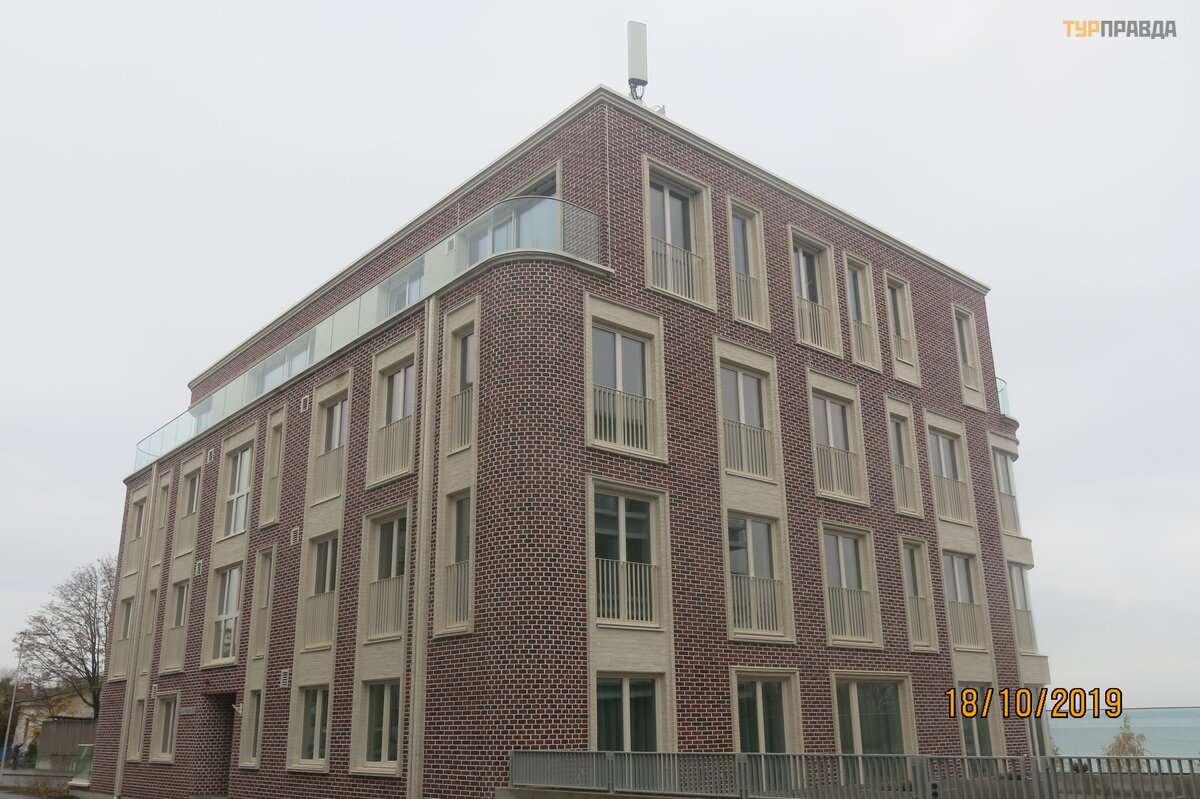
Спускаємося на вулицю Kalaranna, яка веде безпосередньо до Морського музею і з якої відкриваються непогані види на морський порт та Linnahall. Щодо самого Музею. Його експозиція складається з відкритої та закритої. Відкрита – це передусім старовинний криголам «Suur-Tool» (Сюр-Тилль), побудований у 1913 році.


А також іще близько 10 невеликих суден, рибацькі, буксири, прикордонні (деякі пришвартовані на причалі), деякі вже встановлені на березі.
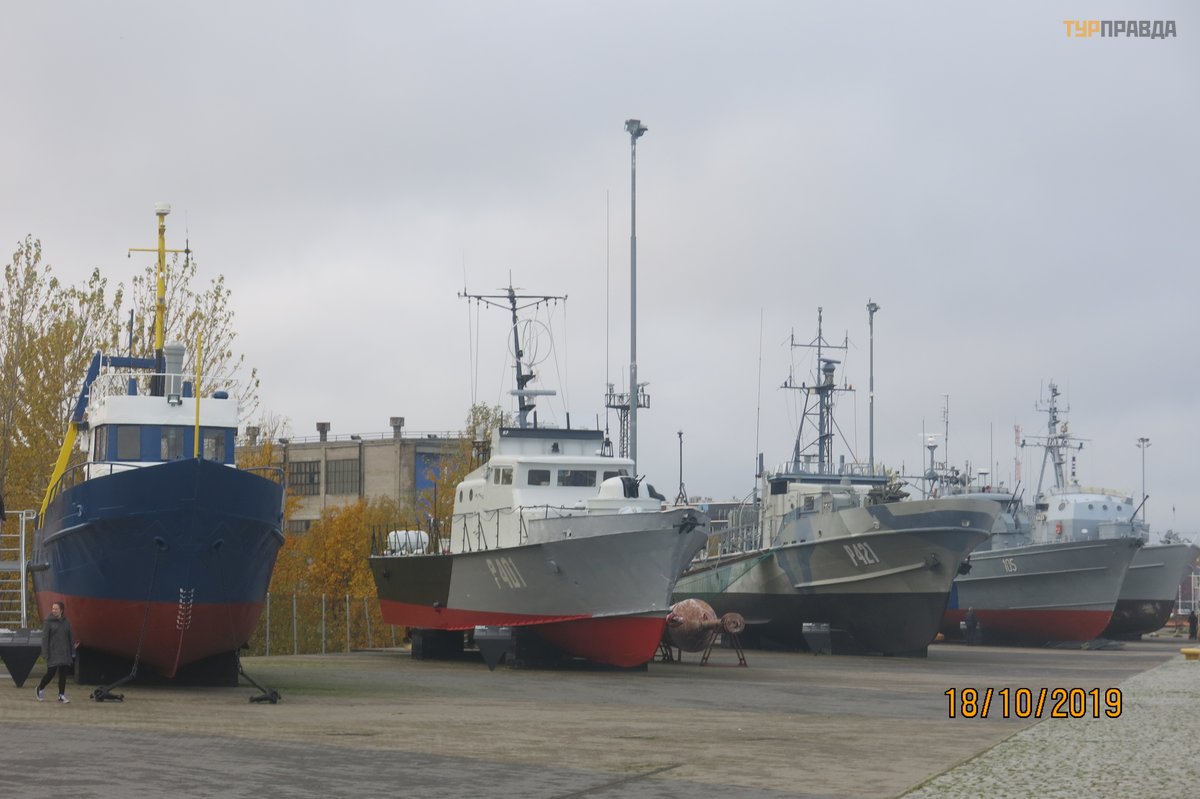

На відкриту експозицію та судна вхід безкоштовний (принаймні, квиток куплений у ангар, де міститься закрита експозиція, в мене ніхто не перевіряв). В ангарі (будівлі – колишній ангар повітряної гавані, коротше кажучи – сховище для гідропланів,побудовано на початку 20 ст., що характерно – напівкруглий дах проектувався без креслень) експонується підводний човен «Lembit» (довжина 56 м, побудовано у 1934 році)...



...гідроплан (про нього чомусь мало інформації, а взагалі техніка дуже цікава), а також всі транспортні засоби та обладнання, що виготовлене (знайдено) на території Естонії – байдарки, вітрильники,буєри (вітрильники на лижах для перегонах на льоду), бакени, буйки і т. п. Звичайно, піднявся на борт підводного човна (оскільки, у нас немає таких як впринципі :-( ). Все цікаво, але дуже тісно. Як моряки пересувалися швидко під час тривоги – загадка. А от про єдиний гідроплан – інформації замало, просто вісить собі під стелею і все.

Навіть зробити його гарне фото – проблемно. Ще в музеї розміщені спеціальні кабіни, де бажаючи можете відчути на собі певні природні явища – вітер різної швидкості, хвилювання моря різної сили тощо. При музеї, звичайно, є сувенірні магазини. Мені півтори години в ангарі вистачило. Є звісно, екскурсанти, що приходять сюди весь день. Забув додати, що вартість квитка для дорослих 15 євро.
Виходимо на зупинку автобуса 73, щоб повернутися в центр. Автобус ходить досить рідко (3 рази на годину). Роздивляємося навкруги. Просто біля зупинки побудовано, на мою думку, просто зразково-показовий житловий масив:

Доїзжаємо автобусом до кінцевої зупинки (Mere puiestee), де знаходиться невеликий ринок народних промислів, переважно виробів з вовни. Зробивши деякі покупки, продовжуємо шлях в центр. Мета – обід у кафе самообслуговування «Lido». Кафе знаходиться в бізнес-центрі в цікавому місці – навпроти будівлі Національної опери Естонії та Концертної зали «Естонія». Ці два культурні заклади знаходяться в одній великій симетричній будівлі:


З іншого боку (вікна кафе виходять саме на нього) – ні більше, ні менше, Музей Національного банку Естонії:

Для порівняння, сам Національний банк Естонії виглядає так:

Після цього вирушаємо до парку «Кадріорг». Для цього підходять трамваї маршрутів №1 та 3. В Талліні курсують звичайні трамваї та трамваї ретро-вінтажного вигляду, присвячені певним історичним особам. Нам дістався трамвай ретро-вінтажного вигляду, присвячений Юліусу Куперьянову (герою війни Першої Світової війни на боці Естонії):

До парку їхати зовсім недовго,не більше 10 хвилин. На шляху до парку трамвай проїхав повз Таллінський Університет (на диво сучасна споруда, що впринципі пояснюється його віком – створений у 2005 році. Можливо, напротивагу головному ВНЗ Естонії – Тартуському Університету, що засновано у 1632 році).
Кадріорг – є найбільшим парком не тільки Таллінна, а й всієї Естонії. Його будівництво розпочато ще в 1713 році і при його будівництві були використані найбільш характерні прийоми паркового мистецтва XVII-XVIII ст. Найбільш популярними місцями парку є околиці Лебединого ставка...
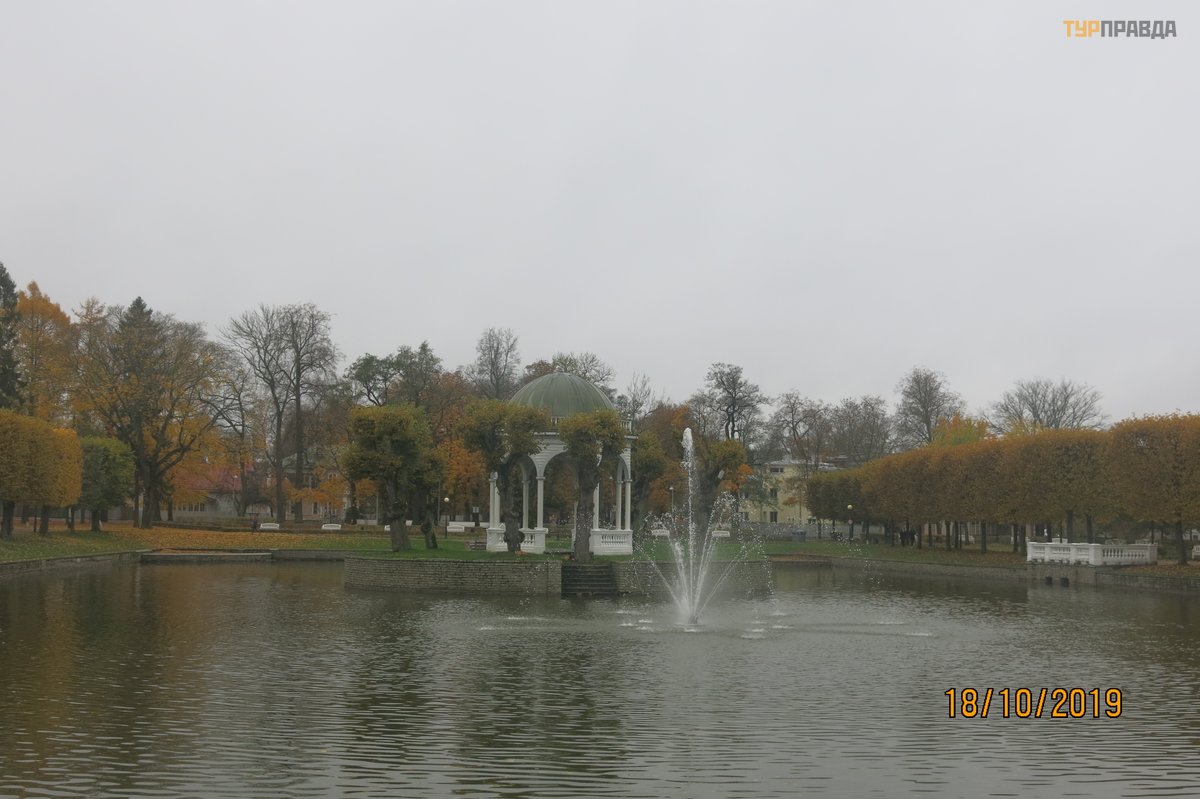
...а також головний променад, що веде до палацу. В парку знаходиться Художній музей...
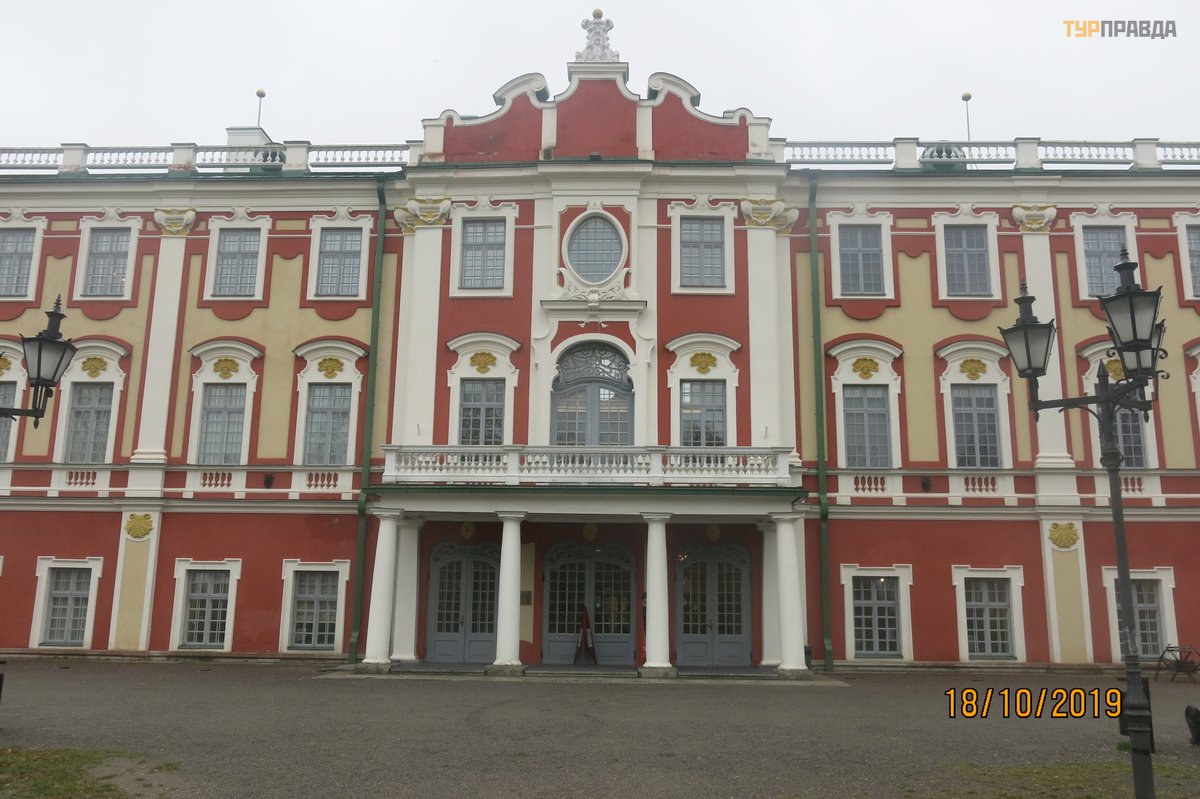
...Музей сучасного мистецтва (музей KUMU), а також резиденція Президента Естонії. Крім того, в парку встановлені монументи деяким діячам естонської культури. Перед художнім музей розбито декілька прекрасних квіткових клумб, а також фонтанів (восени вже не працівали) з міфологічними мотивами:
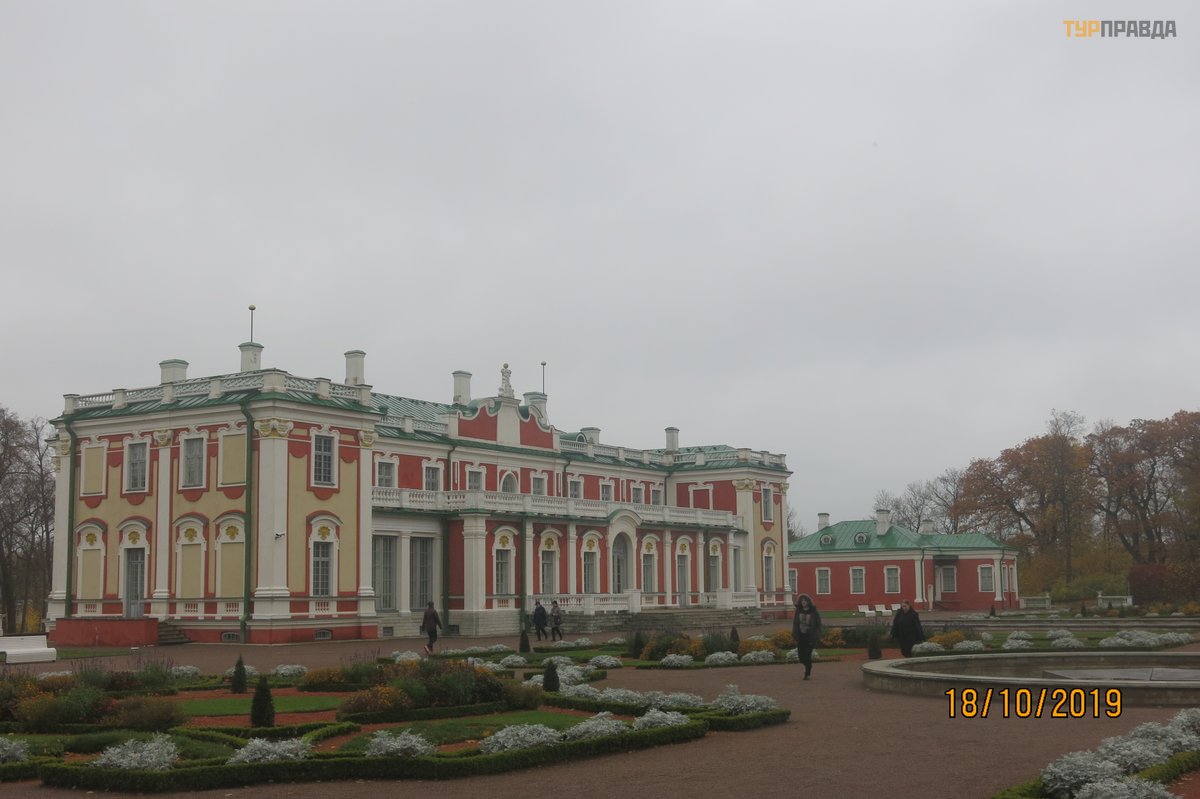

Звернув також на себе уваги ряд лавочок, кожна з яких була присвячена одному з архітекторів (ландшафтних дизайнерів) парку:


Трохи вище парку знаходиться резиденція президента Естонії. Виглядає досить скромно, але з неабияким смаком:
 Резиденція президента Естонії
Резиденція президента Естонії
Напроти резиденції, на галявині помітив ось такі об’єкти:

Вони були ідентифіковані мною як бджолині вулики. Чомусь одразу подумалося про «український слід у Таллінні» (2005-2010 рр.).
Але ця табличка поруч дала зрозуміти, що президентські адміністрації Словенії та Австрії підсуєтилися раніше…
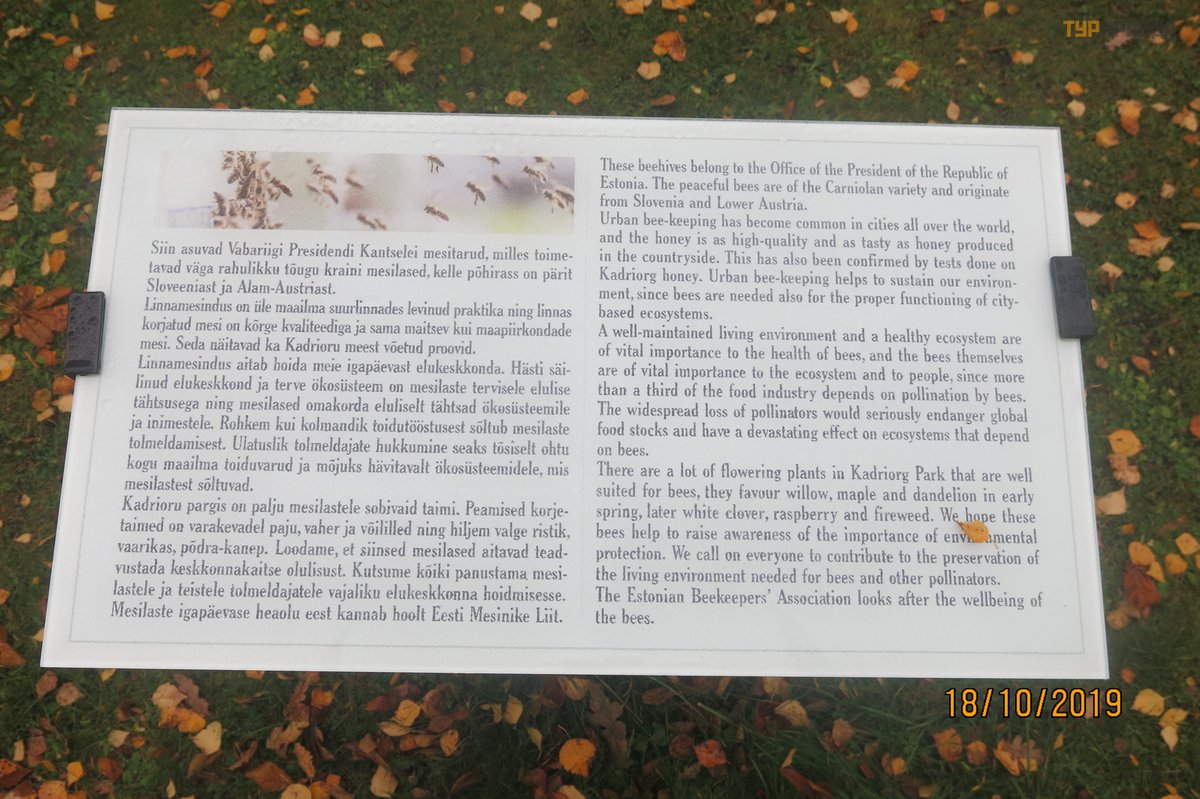
До музею сучасного мистецтва (його ще називають KUMU) вирішили не йти, подальший план – через парк вийти на набережну, а потім пройти (чи підїхати) до пляжу «Піріта» та, можливо, «Співочого поля». Але дощ та масштабні дорожні роботи (через які було змінено рух автобусів, а тротуари взагалі були закриті через укладання асфальту – в дощ (!), так само як і в нас) змінив плани. Але ще трохи про парк «Кадріорг». Він чудовий! Широкі алеї, різні види дерев, неширокі канали з водоспадами і т. д. Багато бігунів,та просто гуляючих, є й іноземні туристи.

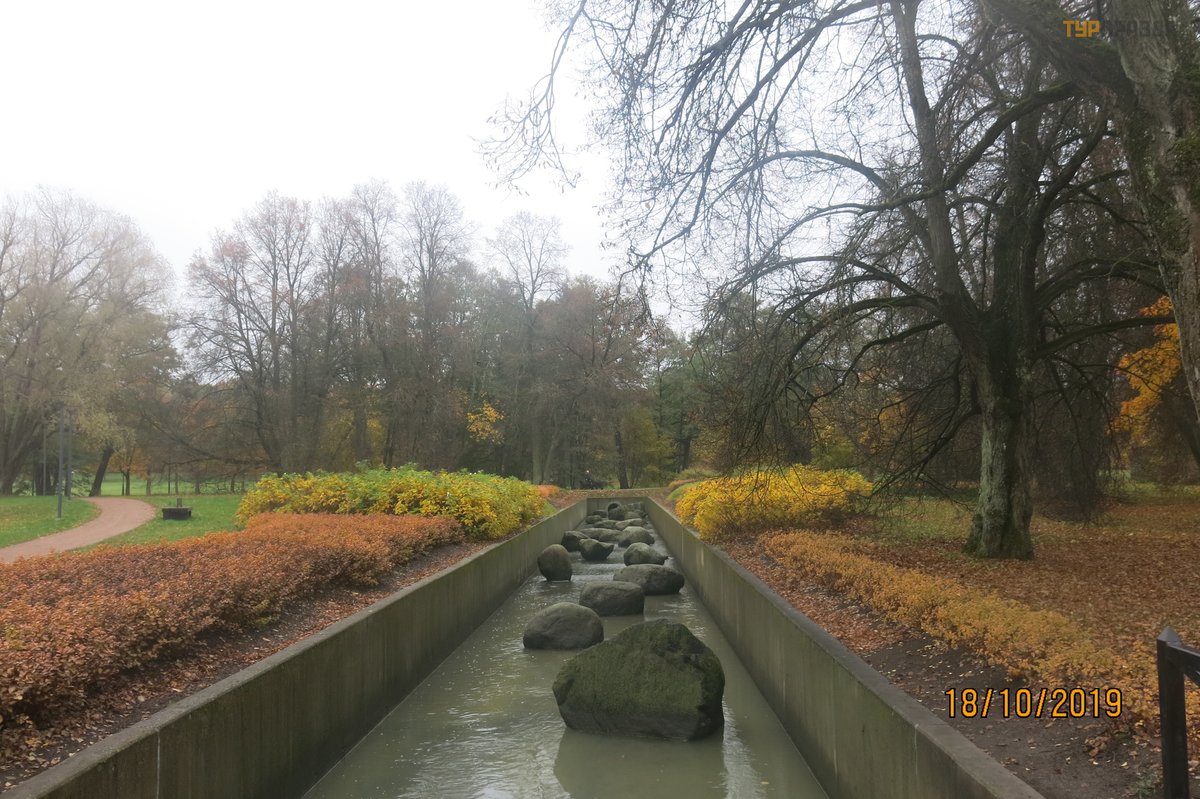
На набережній впорядковуються зони відпочинку. Крім асфальтування, викладаються клумби, при нас з вантажівки з краном вивантажували та встановлювали в певному порядку камені чудернацьких форм.
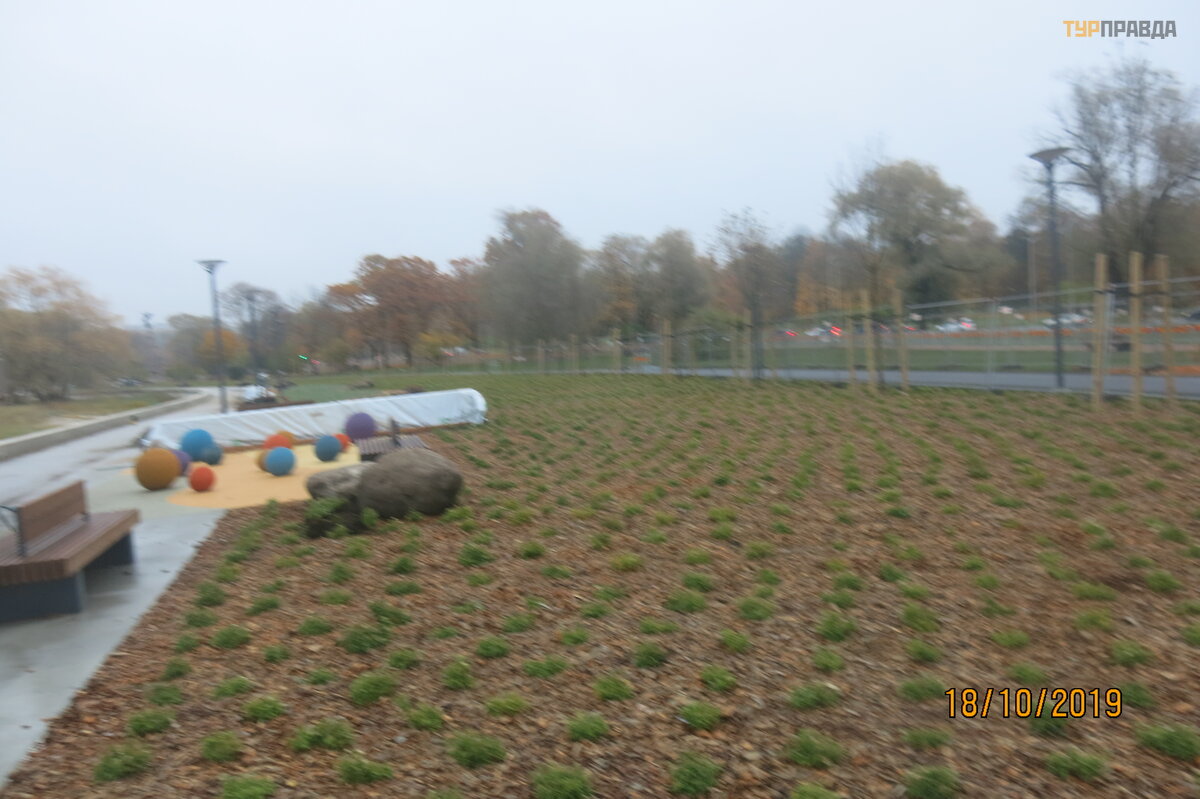
Лавочки та тенісні столи вже встановлені. Протилежний бік набережної (шосе) також впорядковується – 7 років тому там були старі 1-2 поверхові будинки, переважно дерев’яні,за цей час їх знесли, а на їхньому місці будують нові квартали.

Ну і як же без виду на море:

Що можна сказати – Таллінн розвивається в правильному напрямку.
Останній повний день в Естонії. На цей день запланували одноденну поїздку в друге за величиною місто Естонії, засноване ще у 1030 році київським князем Ярославом Мудрим, назване ним Юрьєвим, а нині – її наукову та культурну столицю – місто Тарту. З Таллінна можна дістатись 2 способами: електричкою або автобусом. Перший варіант: поїзд у дорозі 2 години (в один бік), вартість проїзду 10-12 євро; другий варіант – автобус в дорозі 2,5 години (в один бік), вартість поїздки 5-15 євро також в один бік. Враховуючи, що залізничні вокзали в обох містах ближче до центру, ніж автобусні, обрали першій варіант.
Квитки купував напередодні через інтернет (якщо купувати безпосередньо в касі на вокзалі, буде на 15% дорожче). Неділя. Ранок, пасажирів дуже багато. Вокзал у Таллінні не наскрізний (як, наприклад, в Києві, а тупиковий). Наш поїзд прийшов лише за 10 хвилин до відправлення, відправилися з точністю до хвилини. Естонія не пов’язана прямими залізничними рейсами з іншими країнами, тому всі поїзди тут однаково приміські, експресів далекого слідування немає.
Вільних місць майже немає. Поїзди дуже якісні, виробництва Швейцарії, обидва поїзди в нашому випадку були дизельні.

На виїзді з міста проїхали повз головний стадіон країни «Калев» та велике озеро Юлемісте. Зупинки були частими. В Тарту прибуваємо вчасно. Вокзал дуже старовинний (таке враження, що взагалі дерев’яна будівля, на відміну від Талліна – там будівля вокзалу приблизно 1970-х рр.).

В Тарту від вокзалу до центру міста йти приблизно хвилин 20, при бажанні можна підїхати автобусом. Прямо від вокзалу до центру відходить вулиця J. Kuperjanovi, але йти нею не дуже зручно, вона часто петляє. Архітектура – різноманітна:
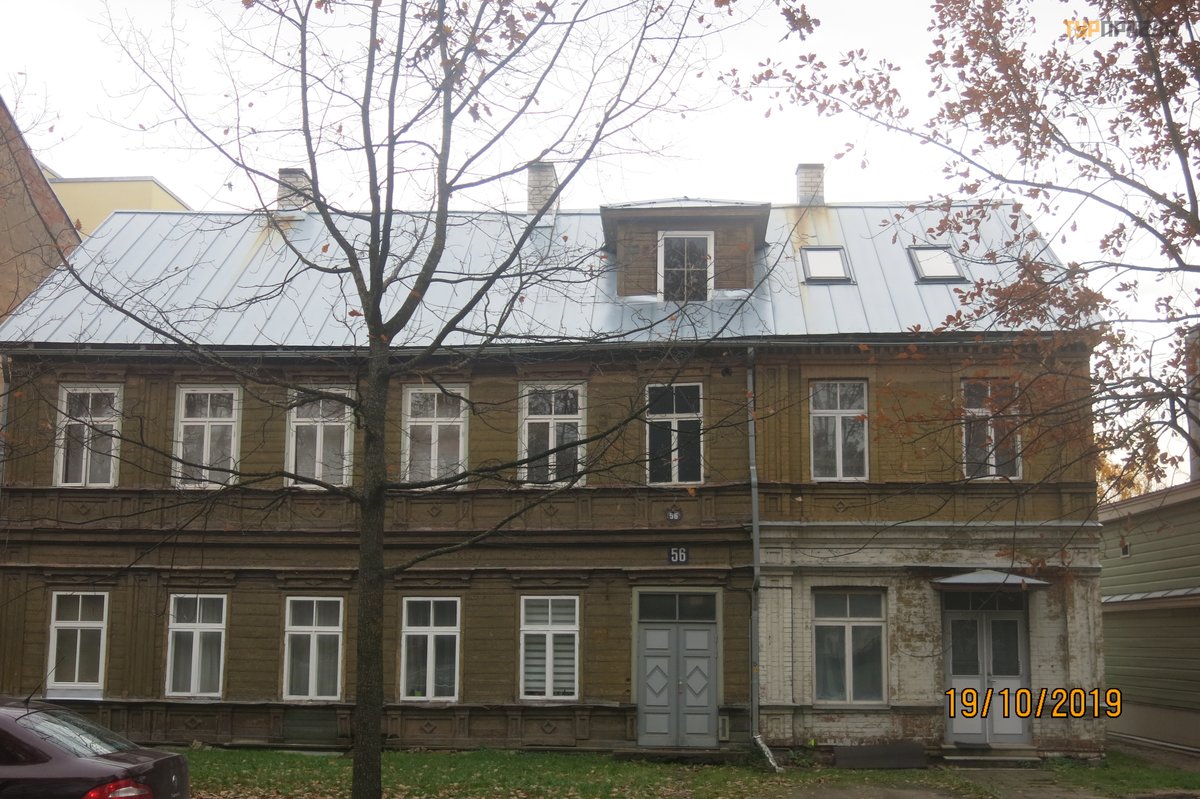


Якщо пройти трохи вправо, то можна йти по вул.Tiigu, вона пряма і дістанетесь до центру швидше. Від перехрестя вул.Tiigu та вул. Akademia, де розташована сучасна студентська бібліотека з невеличким сквером, починається студентський район.
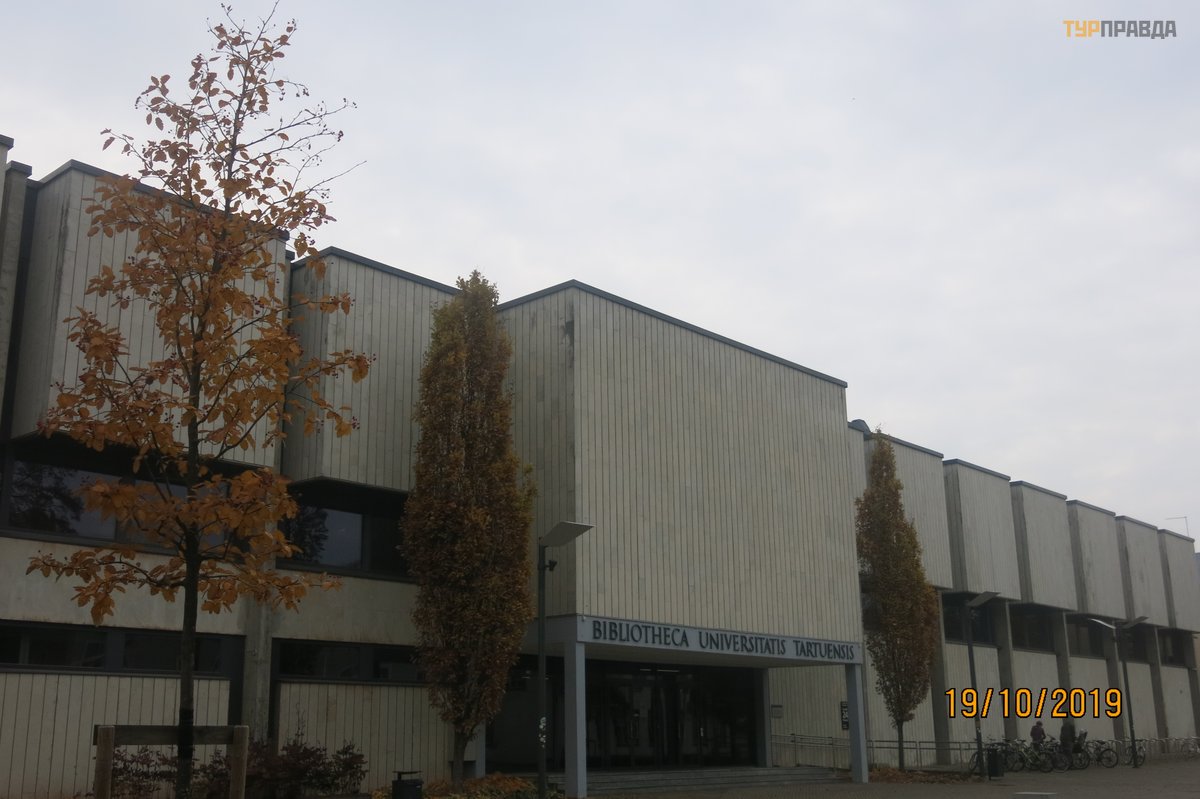
В Тарту знаходяться основні ВНЗ країни: Тартуський державний (класичний) університет, Медичний коледж, Художній коледж, Коледж інформаційних технологій, Військовий коледж (це при тому, що населення міста близько 93 тисяч жителів). На протилежному боці вулиці, якщо спуститись трохи вниз (а Тарту виявилось дуже пагорбистим містом, для полегшення підкорення висот існують дуже старі дерев’янні східці ) розташований центральний театр міста – «Teater Vanemuine», у великій дуже сучасній будівлі. А всього театрів різних жанрів у місті нараховується шість.
По досить крутій вул. W.Struve (названо на честь видатного аістрофізика В. Я. Струве) можна піднятися на університетський пагорб, де знаходиться старовнниа обсерваторія, з якою пов’язана наукова діяльність всіє династії фізиків Струве. Але ми пішли іншим шляхом – по вул. Ulikooli (Університетській) до перетину з вул. Promenaadi (від неї вгору на пагорб починаються старовинні дерев’яні східці), а в провулку перед самим пагорбом, на стінах будинків зображені дуже тематичні графіті (фото, нажаль, немає) – вони присвячені ретро-кінематографу (в 2018 році відзначалося 100-річчя кінематографу Естоніі).
А на самій вуличці встановлено дуже дивну скульптурну композицію – на металевій лавочці становлені скульптури видатного естонського письменника Едуарда Вільде (Eduard Vilde) та ірландського драматурга Оскара Уайльда (Oscar Wilde). Співзвучність прізвищ, а також той факт, що О. Уайльд відвідував Тарту у 1890 році і теоретично міг перетнутись з Е. Вільде, сподвигла автора на такий шедевр. Пам’ятник мало примітний, я побачив його випадково,якщо комусь цікаво – орієнтиром може бути старовинна будівля з червоної цегли (колишня типографія).
Отже по східцям підіймаюсь на пагорб, до старовинної, майже 200-річної обсерваторії.
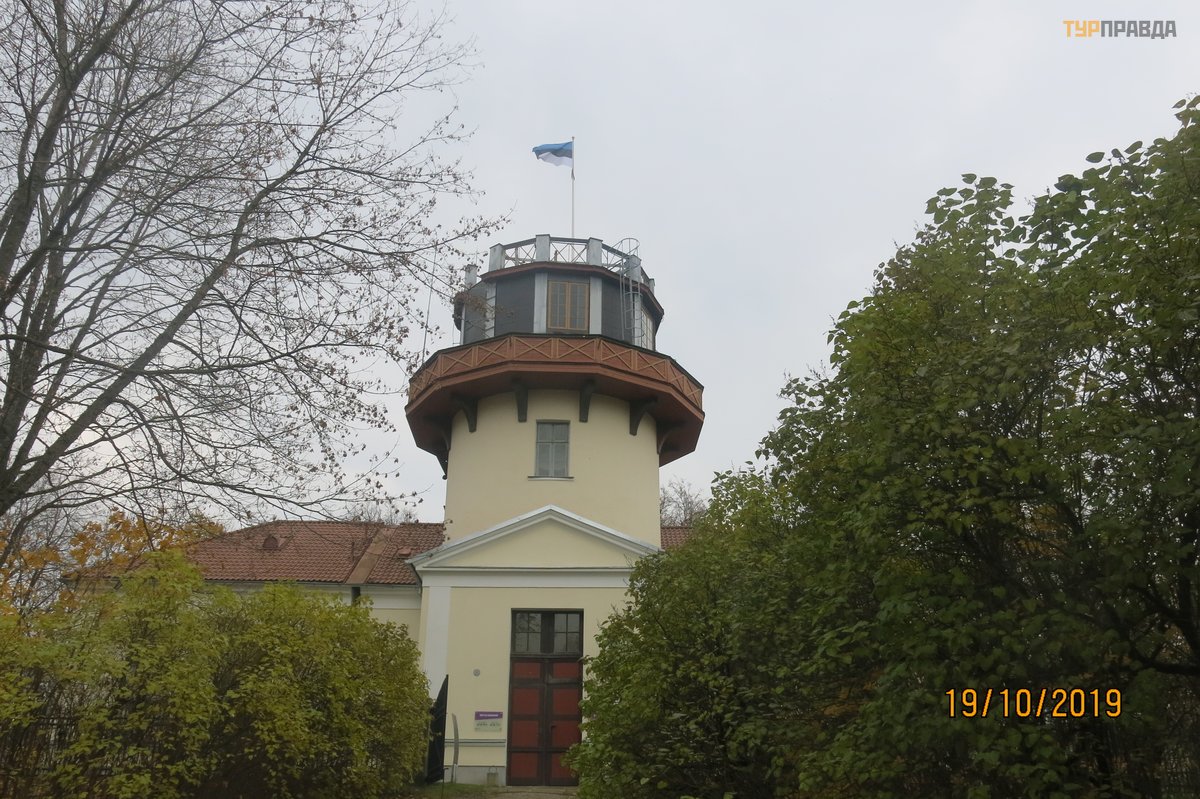
Дорога грунтова, дуже аутентична :-). Поступово вона переходить в Ангельський міст (1814-1816 року, виготовлений з дерева), під мостом проходить похила вулиця Loosi, яка веде до центральних площ та Ратуші.
 Ангельський міст
Ангельський міст
З іншого боку мосту – пагорб Домберг, де знаходиться Музей Тартуського Університету та руїни Домського Собору.

Від мосту до музею тягнеться невеличка алея, з обох боків якої встановлені борди з інформацією про найвидатніших науковців, діяльність яки була пов’язана з Тартуським університетом:

У невеличкому сквері поруч встановлений дуже оригінальний пам’ятник – велика металева печатка з зображенням першого ректора університету Йохана Скітте (Johan Skytte), а на відтиску – герб університету і відповідні написи естонською та німецькою мовами (на момент створення Тарту був німецьким містом і називався Дерпт):

Далі по вул. Лоосі спускаємося в центр. Цетром міста є дві площі – площа М. І. Пирогова (з пам’ятником знаменитому лікарю) та Ратушна площа. Їх розділяє безпосередньо сама Ратуша. На Ратушній площі встановлено фонтан із життєстверджувальною композицією «Студенти, що цілуються» (хлопець і дівчина під парасолею). Оригінальність фонтану ще й в тому, що вода подається не тільки знизу, з басейну фонтану, а й зверху – безпосередньо з парасолі:

Крім ВНЗ та театрів, Тарту відзначається й своїми дещо незвичними музеями. Окрім вищезгаданого Музею університету, в місті також є художній музей, музей іграшки, музей міського жителя 19 ст., музей друкарської справи, музей спорту та олімпійських ігор тощо. Останній, до речі, знаходиться зовсім поруч з Ратушною площею – достатньо пройти метрів 100 по вул. Ruuti (на якій, якщо цікаво, набільше скупчення кафе, але переважно фастфуд). Зовсім поруч – і красива Церква Св. Яна, побудована з червоної цегли.
А якщо перети на паралельну вулиця (вже згадувану трохи раніше Ulikooli, то можна побачити і сам головний корпус Таллінського університету. Будівля настільки класична і монументальна, що тільки по зовнішньому вигляду (без вивіски) можна зробити висновок, що в ній знаходиться або кількасотрічний класичний ВНЗ або якась дуже серйозна урядова установа:
 Університет Тарту, головний ВНЗ Естонії
Університет Тарту, головний ВНЗ Естонії
Закінчуємо з Тарту середньовічним і рушаємо в бік Тарту сьогоднішнього і Тарту майбутнього. А саме на набережну місцевої ріки Emajogi. З набережної відкриваються гарні види на білий арочний пішохідний міст, багатоповерхівки сучасного Талліна – 15-поверховий бізнес-центр, та 23-поверховий оригінальний білий житловий будинок циліндричної форми «Tiigutorn».
 Вид з набережної на сучасний Тарту
Вид з набережної на сучасний Тарту
За яким сховався науково-розважальний центр AXXAA з музеєм науки та діючим планетарієм. Але туди ми вже не дійшли. Пообідали в «Vapiano»у великому ТЦ «Kvartal», хоча вже пізніше на іншому поверсі побачили місцевий аналог "Lido". Трохи перепочивши у парку поруч, вирушили до залізничного вокзала, йшли вже іншою дорогою, вздовж широкої та швидкісної вулиці Riigi, яка, я так розумію, за містом переходить у Ризьку трасу. Єдиним об’єктом на нашому шляху, що заслуговував на увагу, був Військовий коледж.
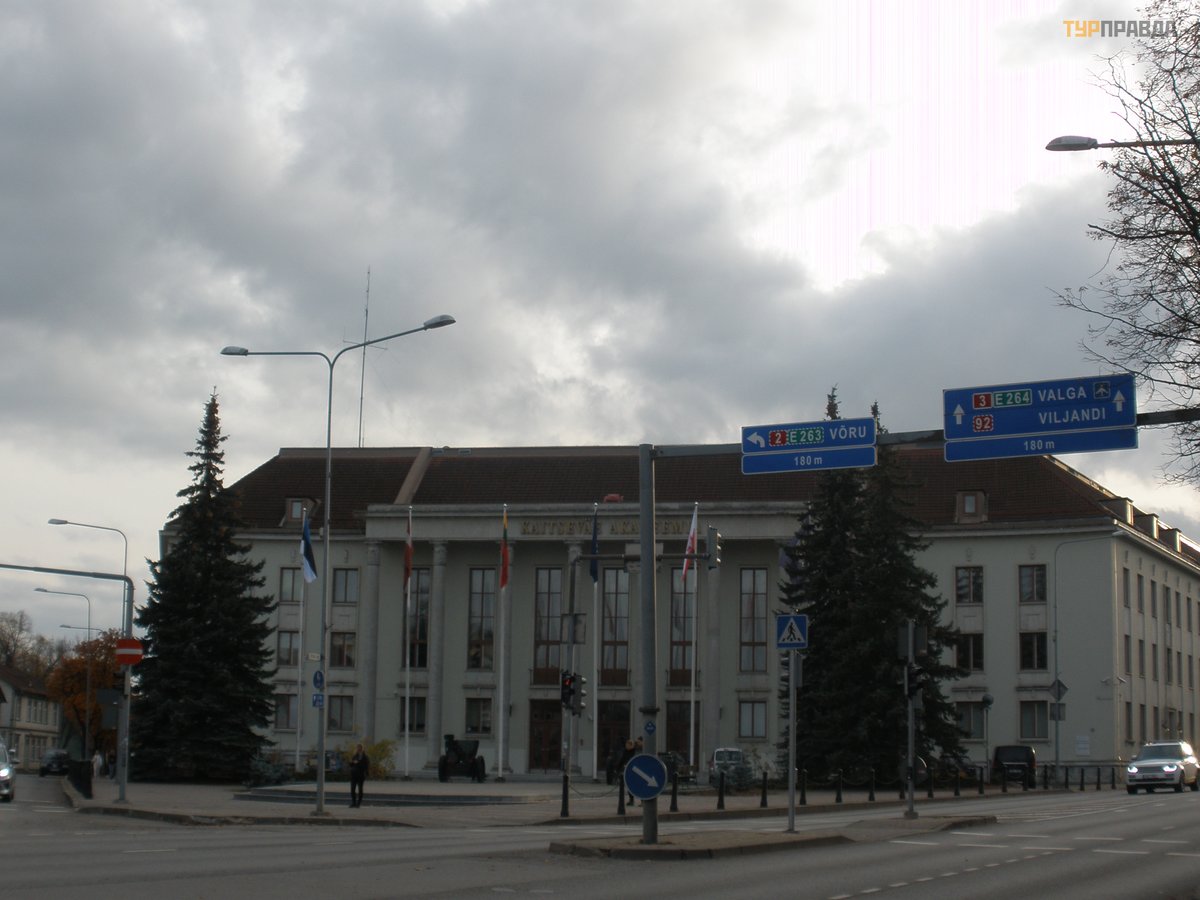 Військовий коледж
Військовий коледж
З віддаленням від центру та наближенням до вокзалу, типові цегляні будинки поступалися місцем дерев’яним або комбінованим. Незважаючи на суботу, на вулицях було тихо і майже порожньо. Такою неспішністю і спокоєм і запам’яталося мені друге за величиною місто Естонії.
День від’їзду. Рейс об 11:40, сніданок в готелі в неділю тільки з 08:00 (в інші дні з 07:00). Спускаємося вниз з речами на півгодини раніше (речі можна при цьому залишити на стелажах у спеціальній кімнаті за рецепцією). Автобус відходить від Терміналу А порту о 08:52. За 30 хвилин вже в аеропорту. В R-кіоску повертаю карту (одразу виплачують залишок коштів та вартість самої картки) та отримую tax-free (процедура: спочатку у вікні CUSTOM проштампувати чеки, а вже після після проходження всіх контролів, біля гейту 1, в кіоску обміну валют вам повернуть кошти готівкою). Вилетіли вчасно стандартним Візейрівським Airbus. Трохи незвично було, що екіпаж на борту був не естонським, не українським, а польським, все було дуже ввічливо, по-європейськи.
Такою ж європейською країною і залишиться в моїй уяві Естонія. Країна, що за минулі 7 років (з моменту мого минулого відвідання) значно просунулась і продовжує просуватися в європейські цивілізаційні структури, причому без руйнування, а тільки із збереженням свого національного минулого.
Балтійська осінь. Частина 3. Фінляндія >>>
Baltic Autumn. Part 1. Latvia>>>
… a column with the symbol of the European Union and the inscription "Estonia" flashed outside the bus window. Compared to Latvia, at first glance, nothing has changed - the same yellow-red-green mixed forest, all the same small villages / hamlets through which the sea can be seen somewhere… Although the further north, the more often the bus rushed past the population . points, consisting not only of one-story wooden houses - sometimes seen and the so-called "urban-type settlements" with three-, four-story apartment buildings targeted. Probably originated at factories or other important facilities. There was one stop - both for boarding / disembarking passengers - in the city of Pä rnu. It was not possible to get a complete picture of the main resort of Estonia - the same one-story private building, small parks. Tallinn suburbs have already appeared on the horizon.
We drove to the city through the woods, through a new area.

Noting that at the entrance to the city there were 2 small shopping centers (almost like ours). First impressions - the city has many transport interchanges, and not very convenient, the second - as soon as we left the forest to the city on the plain, immediately became visible historical center on the hill Toompeaa. The houses in the center are three-, four-storey, made of white and gray bricks, not new (approximately 1950-1960), but well preserved. Finally, the end - the bus station (in Estonian Bussijaam). Immediately on the platform is the T-kiosk, which, among other things, sells public transport tickets. I buy an e-CARD (2 euros collateral value) and put 10 euros on the card. Funds on the card will be used to pay for travel, the cost of the trip on the card is € 1.10, the duration of the trip is 60 minutes, transfers are possible. On tram №2 we go to our hotel.
We leave at the 5th stop ("Linnahall"), the landmark - the Sea Gate and the tower "Fat Margarita" and head to our hotel on the waterfront.
I suddenly came to Tallinn (first time in August 2012, story ) and the area not knowing. Seven years ago there were old one-, two-storey (sometimes even wooden) houses, now in their place are either built office centers of glass and concrete, or construction continues. Our hotel is called "Tallink Express Hotel" (263 euros / 5 nights / twin), in 2012 was a neighbor, but located in the same building "Tallink SPA & Conference Hotel". The hotel is completely satisfied (quiet, very good breakfast, great location - 15 minutes to Terminal A seaport, 10 minutes to the historic center, 5 minutes to the bus stop to the airport, 20 minutes to the train station).
While we settled - it's getting dark, it's too late to go to the center, we decide to visit the store "Rimi", which from memory was on the other side of the Admiralty Bay (in fact - a marina for yachts and an ancient tug). The store was not found immediately (for the last 7 years on the opposite shore of the bay built 3 large chains. H&M, New Yorker, Deichmann, etc. After a little shopping we return to the hotel.
The next day after breakfast we go to the Old Town. We enter through the Sea Gate on Pick Street.
 Морские ворота. Left - "Fat Margarita"
Морские ворота. Left - "Fat Margarita"
Morning. Quiet and almost deserted. The Church of St. Olaf (Oleviste) is all in the woods, so it is probably closed.

In the next quarter, the architectural ensemble "Three Sisters" stands out (there is a very expensive hotel).
 " Three sisters "
" Three sisters "
At Pagari and Suurtuki streets we go to the Fortress Wall (also a Tallinn landmark), near the wall there is Laboratorium Street, where the Ukrainian Cultural Center and the Ukrainian Greek Catholic Church are located near the house №22.
 UGCC in Tallinn
UGCC in Tallinn



The church is in the yard and was closed (the service of that day - only in the evening). On Lai Street, past the old theater building, we approach the Town Hall Square.
Noting that on the houses under the roof there are hooks (Dutch style), on which were attached ropes, which were used to pull loads to the upper floors (stairs in medieval houses are narrow and steep).

After Roheline Turg begins the "restored chic" - old Art Nouveau houses of modern renovation, many diplomatic missions, a theater, the house of the St. Knudt Guild, now there is a theater school.






There is no information about the "Ukrainian trail".
Nearby is the famous dragon house (a classic of Tallinn Art Nouveau).
Gradually descend to the Town Hall Square.
Here is the ancient Town Hall of Tallinn with the unofficial symbol of the city - Old Thomas (weather vane by a knight with a long mustache). After a photo shoot in the square, we go to the Upper Town (directly to the castle Toompea), first on the street. Dankri, briefly converted to the Church of St.
Nicholas (Niguliste) - now there is a museum of ecclesiastical art, the entrance fee - € 8.
 Orthodox church of St. Nicholas (Niguliste)
Orthodox church of St. Nicholas (Niguliste)
After a fairly steep climb up the stairs of Luhige-Jalg Street, we go out right next to the "Garden of the King of Denmark" - a small park under the fortress wall, which houses a wooden gallery, very atmospheric. One of the expositions of the Museum of the History of Tallinn is located in the restored tower Neitsitorn (it turns out that it is more or less a UNESCO World Heritage Site).
 Neitsitorn Tower
Neitsitorn Tower
This park is a reminder of the 100-year rule of Denmark in Tallinn.
The entourage of the Middle Ages is complemented by metal sculptures of three Franciscan monks and an ancient cannon.
 " Сад Датского Короля "
" Сад Датского Короля "
There are also beautiful views of the lower city.
Through the medieval gates we enter the Upper Town, which is actually part of Tallinn Castle. The Upper Town is dominated by the 46-meter Long German Tower (built in 1370), on the mast of which the Estonian flag is waved, which is raised daily at sunrise and lowered at sunset.
 " Long German "
" Long German "
A majestic 18th-century house complex is attached to the tower, which houses the Riigikogu - the Estonian Parliament
 Estonian Parliament
Estonian Parliament

Next to the parliament is a small park with a rosary and essential shops.
Almost the opposite, if you walk down the street Toom-Koli medieval building of the Main Post Office, and even further - the Cathedral (Dome) Cathedral. Externally, as internally, he is very ascetic. Entrance - 3 euros.
 В Домском Соборе
В Домском Соборе
In the afternoon, between services, organ music concerts are held in the cathedral. On Dome Square we return to Rahukohtu Street, which ends with an observation deck, two large souvenir shops (with a wide selection of amber products) ...

...and the building of the Cabinet of Ministers of Estonia.

After a photo shoot with views of the seaport, train station, old quarters and modern areas (everyone chooses the views he likes) ...



and shopping, back to the center. Along the way - also photographed on the narrowest street of Tallinn (first turn left of Rahukohtu, if you go to the center).
In the Lower Town we go down Pikk-Jalg Street, not as steep as Luhige-Jalg, but longer (locals call Pikk-Jalg "long leg" and Luhig-Jalg "short leg"). From the Lower Town, again through the Town Hall Square through the Viru Gate (and next to the flower market), we exit to Viru Avenue, the first building of the 23-storey Hotel Viru, the first 6 floors of which are occupied by the modern Viru Keskes department store (built in 1984) . . There are few shops and boutiques in the department store more than 100 cafes, but all of them for some reason with restaurant prices and claims to haute cuisine.
Interesting story with WC. In Viru Keskes they are paid (0.2 euros per coin), access is organized through a turnstile. For those who do not have a coin of the specified denomination, there is a machine for exchange. The machine exchanges coins 1.
2 euros and 5 euros.
The range and prices in the cafe in the department store did not impress, we decided to have lunch opposite - in one of the cafes in the "Rotterman".
The Rotterman quarter is a historic district opposite the port (built in the second half of the 19th century). It was an industrial zone with port warehouses and a small factory for the production of building materials with the famous chimney. In the second half of the twentieth century. production was closed and the area was in decline for some time. It entered the history of cinema as the location of the fantastic philosophical film "Stalker". In the 2000s. The buildings of the quarter were privately demolished (but the chimney was left for history), and the rest were converted into modern offices, art galleries, cafes, shops.
We had lunch in the VAPIANO chain cafe (we had to visit the establishments of this network in Germany), 16 euros for two, quite decent.
It was a bit blown away that some of the staff were frankly Indo-Pakistani in appearance (besides, I had never seen Asian natives in Latvia and Estonia, non-tourists).
Probably arrived in Tallinn as part of an intra-corporate relocation.
After lunch we decide to extend the theme of shopping. To do this, go to the shopping center Prisma (I remember him on a trip in 2012), take the bus №17. An interesting nuance on the method of payment: when paying for travel with E-card, only 3 trips per day are deducted (I found out on my return), as it is if you use public transport 4 times a day or more - it is unclear. I have never seen controllers in public transport. The ride is short, about 15 minutes.
Over the past 7 years (since the hour of my previous visit), the Prisma shopping center has changed a lot - another shopping center (Kristina) has been added to it much larger in size.
This is no longer the center, the area around the typical 4-5 storey houses (approximately 1953-1963), but very well maintained, without creatively glazed balconies and satellite dishes recently restored.

The Prisma-Kristina shopping center impressed not only with its size, but also with its range, in addition to well-known transnational brands, many local brands, as well as brands from Scandinavia. In the evening we return to the hotel. The next day - early rise and a day cruise to Helsinki (there will be a separate story).
On the third day we decided to visit "Lennusadaam" - the Maritime Museum of Estonia. It can be reached by bus №73, from the nearest stop, which is near the "Tolstoy Margarita" (called "Linnahall") to go only 2 stops, but they were long enough, which is not typical for Tallinn. We came to this conclusion when we decided to take a walk. At the same time, we saw a lot of interesting things. But everything is in order.
When walking from our hotel on Sadaama Street towards the historic center, a rather strange monumental building on the seashore catches your eye.
From a distance, it looks like a large uneven pedestal of irregular shape, behind the upper surface of which a ladder with railings climbs single passers-by, apparently without specific goals, just to walk.
As it turned out, this is Linnahall - a grand sports and concert complex, built privately underground. It (along with several other sports facilities) was built before the XXII Olympic Games in 1980. The capacity of the facility is 5.300 spectators in the concern hall and about 1.000 seats in the hockey arena. The building is currently equipped with a helipad, Tallinn Linnahall Heliport, with regular flights to Helsinki , and a small port for Linda Line boats.
Judging by its appearance, Linnahall is not currently used for its intended purpose, at least on the website ( www. Linnahall. Ee ) no events are planned, there is only information about past events and archival photos.
 " Linnahall ". Two in one: Sports Palace and Concert Rally. Has not functioned for the last 10 years: - (
" Linnahall ". Two in one: Sports Palace and Concert Rally. Has not functioned for the last 10 years: - (
But I got a little distracted. From the bus stop with the same name "Linnahall" turn to the street Suur-Patarel. Here begins a completely different Tallinn - a quarter of the same 2-3-storey houses, decorated in antiquity.

And a little further - low-rise new buildings in a modern, so-called "Scandinavian" style.

Although on the other side of the street are built houses of all ages, different styles.


 >>
>>
We descend to Kalaranna Street, which leads directly to the Maritime Museum and offers good views of the seaport and Linnahall. About the Museum itself. Its exposition consists of open and closed.
The open one is first of all the old icebreaker "Suur-Tool" (Sur-Till), built in 1913.


As well as about 10 small vessels, fishing, tugs, border (some moored at the pier), some are already installed on shore.


Admission to the open exposition and the court is free (at least, no one has checked my ticket to the hangar where the closed exposition is located). In the hangar (buildings - the former hangar of the air harbor, in short - storage for seaplanes, built in the early 20th century.
, which is typical - the semicircular roof was designed without drawings) exhibits a submarine "Lembit" (length 56 m, built in 1934) ...



seaplane (about him for some reason little information, and in general the equipment is very interesting), as well as all vehicles and equipment manufactured (found) in Estonia - kayaks, sailboats, buoys (sailboats on skis for ice racing), beacons, buoys, etc. Of course, got on board a submarine (because we do not have such as in principle: - (). from about a single seaplane - little information, just hang yourself under the ceiling and all.

Even taking a good photo of him is problematic.
The museum also has special cabins, where you can feel certain natural phenomena - wind of different speeds, sea waves of different strength, etc. At the museum, of course, there are souvenir shops. An hour and a half in the hangar was enough for me. There are, of course, tourists who come here all day. Forgetting to add value for adults 15 euros.
Get off at bus stop 73 to return to the center.
The bus is quite rare (3 times an hour). We look around. Just at the stop built, in my opinion, just a model housing estate:

We take a bus to the final stop (Mere puiestee), where there is a small market of folk crafts, mostly products from outside. After making some purchases, we continue our way to the center. The goal is lunch at the Lido self-service cafe.
The café is located in the business center in an interesting place - opposite the Estonian National Opera House and the Estonia Concert Hall. These two cultural institutions are located in one large symmetrical building:


On the other hand (the windows of the cafe overlook it) - no more, no less Museum of the National Bank of Estonia:

For comparison, the National Bank of Estonia itself looks like this:

After that we go to Kadriorg Park. Trams of routes №1 and 3 are suitable for this purpose. Tallinn runs regular trams and retro-vintage trams dedicated to certain historical figures. We got a retro-vintage tram dedicated to Julius Kuperyanov (hero of the First World War on the Estonian side):

It doesn't take long to go to the park, no more than 10 minutes. On the way to the park, the tram passed the University of Tallinn (surprisingly modern building, which in principle is due to its age - created in 2005. Probably opposite the main university in Estonia - the University of Tartu, founded in 1632).
Kadriorg is the largest park not only in Tallinn, but in the whole of Estonia.
Its construction began in 1713 and during its construction the most characteristic methods of park art of the XVII-XVIII centuries were used. The most popular places in the park are the surroundings of the Swan Pond ...

...as well as the main promenade leading to the palace. The park houses the Art Museum ...

...Museum of Contemporary Art (KUMU Museum), as well as the residence of the President of Estonia. In addition, the park has monuments to some figures of Estonian culture.
In front of the art museum there are several beautiful flower beds, as well as fountains (no longer working in the fall) with mythological motifs:


Also note a number of benches, each of which was dedicated to one of the architects (landscape designers) of the park:


A little above the park is the residence of the President of Estonia. It looks quite modest, but with a dozen tastes:
 Residence of the President of Estonia
Residence of the President of Estonia
Opposite the residence, on the lawn, I noticed the following objects:

They were identified by me as bee evidence. For some reason, I immediately thought about the "Ukrainian trail in Tallinn" (2005-2010).
But this sign next to it made it clear that the presidential administrations of Slovenia and Austria got involved earlier ...

We decided not to go to the Museum of Modern Art (also called KUMU), the next plan is to go through the park to the waterfront, and then walk (or drive up) to Pirita Beach and, possibly, the Singing Field.
But the rain and large-scale road works (due to which the movement of buses was changed, and the sidewalks were closed due to the laying of asphalt - in the rain (! ), As well as in our country) changed the plans. But a little more about Kadriorg Park. He is magnificent! Wide alleys, different types of trees, narrow canals with waterfalls, etc. Many runners, and just walking, there are foreign tourists.


Recreation areas are being arranged on the waterfront.
In addition to asphalting, flower beds are laid out, we have unloaded and installed in a certain order stones of bizarre shapes from a truck with a crane.

Benches and tennis tables are already installed.
The opposite side of the embankment (highway) is also put in order - 7 years ago there were old 1-2-storey houses, mostly wooden, during this hour they were demolished, and new neighborhoods are being built in their place.

Well, what about the sea view:

What can be said - Tallinn is developing in the right direction.
Last full day in Estonia. On this day, a day trip is planned to the second largest city in Estonia, founded in 1030 by the Kiev prince Yaroslav the Wise, named after him Yuriev, and now - its scientific and cultural capital - the city of Tartu.
There are 2 ways to get from Tallinn: by train or by bus. The first option: train by the road 2 hours (one way), fare 10-12 euros; another option - a bus journey of 2.5 hours (one way), the cost of the trip 5-15 euros also one way.
Given that the railway stations in both cities are closer to the center than the bus, we chose the first option.
I bought tickets the day before via the Internet (if you buy directly at the box office at the station, it will be 15% more expensive). Sunday. Morning, a lot of passengers.
The station in Tallinn is not through (as, for example, in Kiev, but a dead end). Our train arrived just 10 minutes before departure, departed to the nearest minute. Estonia is not connected by direct rail flights with other countries, so all trains here are still suburban, there are no long-distance express trains.
There are almost no vacancies. The trains are very high quality, made in Switzerland, both trains in our case were diesel.
ru / newimg / 3 / 1200x800 / 00/02/60/55 / .2605599.jpg "target =" _ blank " rel="nofollow"> 
On the way out of the city we passed the main stadium of the country "Kalev" and the big lake Yulemisto. Stops were more frequent. We arrive in Tartu on time.
The station is very old (the impression is that it is a wooden building in general, unlike Tallinn - there is a station building around the 1970s).

In Tartu from the station to the city center to go about 20 minutes, if desired, you can take a bus.
J. Kuperjanovi Street goes straight from the station to the center, but it is not very convenient to walk on it, it often meanders. Architecture - diverse:



If you go a little to the right, you can go on the street. Tiigu, it's straight and you'll get to the center faster. From the intersection of st. Tiigu and st.
The Akademia, which houses a modern student library with a small square, begins the student district.

Tartu is home to the country's main universities: Tartu State (Classical) University, Medical College, College of Arts, College of Information Technology, Military College (with a population of about 93.000).
On the opposite side of the street, if you go down a little (and Tartu turned out to be a very hilly city, there are very old wooden stairs to facilitate the conquest of heights) is the central theater of the city - "Teater Vanemuine", near a large very modern building. And there are six theaters of different genres in the city.
On a rather steep street. W. Struve (named after the outstanding astrophysicist V. Ya.
Struve can climb the university hill, where there is an ancient observatory, which is associated with the scientific activities of the entire dynasty of Struve physicists. But we went the other way - st. Ulikooli (University) before crossing with st.
Promenaadi (from it up the hill begin the old wooden stairs), and in the alley in front of the hill, on the walls of the houses are painted very thematic graffiti (photo, unfortunately, no) - they are dedicated to retro cinema (in 2018 there were 100 Estonian cinemas ).
And on the street there is a very strange sculptural composition - on a metal bench are sculptures of the outstanding Estonian writer Eduard Vilde (Eduard Vilde) and Irish playwright Oscar Wilde (Oscar Wilde). The consonance of the surnames, as well as the fact that O. Wilde visited Tartu in 1890 and could theoretically intersect with E. Wilde, inspired the author to such a masterpiece.
The monument is not very remarkable, I saw it by chance, if anyone is interested - the landmark may be an old building of red brick (former printing house).
So I go up the stairs to the hill, to the ancient, almost 200-year-old observatory.

Expensive ground, very authentic : -). Gradually, it will move to the Angel Bridge (1814-1816, made of wood), under the bridge is a sloping street Loosi, leading to the central squares and the Town Hall.
 Ангельский мост
Ангельский мост
On the other side of the bridge is Domberg Hill, home to the University of Tartu Museum and the ruins of the Dome Cathedral.

From the bridge to the museum there is a small alley, on both sides of which there are boards with information about outstanding scientists, whose activities were related to the University of Tartu:

In a small square there is a very original monument - a large metal seal with the image of the first rector of the university Johan Skytte (Johan Skytte), and on the imprint - the university emblem and the corresponding inscriptions in Estonian and German (at the time of its creation and was called Dorpt):

Next on the street. Loosi descends to the center. The center of the city are two squares - MI Pirogov Square (with a monument to the famous doctor) and Town Hall Square. They are shared directly by the Town Hall itself.
A fountain with a life-affirming composition "Kissing Students" (a guy and a girl under an umbrella) is installed on the Town Hall Square. The originality of the fountain is that the water is supplied not only from below, from the pool of the fountain, but also from above directly from the umbrella:

Crimea universities and theaters, Tartu is also noted for its somewhat unusual museums.
We finish with Tartu medieval and go to Tart today and Tart future. Namely on the embankment of the local river Emajogi. The promenade offers beautiful views of the white arched pedestrian bridge, the high-rise buildings of modern Tallinn, a 15-storey business center, and the 23-storey original white cylindrical dwelling house Tiigutorn.
 View from the embankment to modern Tartu
View from the embankment to modern Tartu
Behind which is the AXXAA Science and Entertainment Center with a science museum and a functioning planetarium. But we didn't get there. We had lunch at "Vapiano" near the large shopping center "Kvartal", although later on the second floor we saw a local analogue of "Lido". After a short rest near the park nearby, we went to the train station, walked on another road, along the wide and fast street Riigi, which, as I understand it, crosses the city near the Riga highway.
The only object on our way that deserved attention was the Military College.
 Военный колледж
Военный колледж
As we moved away from the center and closer to the station, typical brick houses gave way to wooden or combined ones. Despite Saturday, the streets were quiet and almost empty. I remember Estonia's second largest city with such slowness and calmness.
Departure day. Flight at 11:40, breakfast at the hotel on Sunday only from 08:00 (on other days from 07:00).
We go down with the speeches half an hour earlier (things can be left on the shelves near a special room at the reception). The bus departs from Terminal A of the port at 08:52. In 30 minutes already at the airport.
In the R-kiosk I return the card (I immediately pay the balance and the cost of the card itself) and receive tax-free (procedure: first in the CUSTOM window in cash). We took off on time with a standard Viseur Airbus.
It was a bit unusual that the crew on board was not Estonian, not Ukrainian, but Polish, everything was very polite, European.
Estonia is the same European country in my imagination. Over the past 7 years (since my last visit), the country has made significant progress and continues to move into European civilizational structures, without destruction, but only with the preservation of its national past.
Baltic Autumn. Part 3. Finland >>>
 Морские ворота. Left - "Fat Margarita"
Морские ворота. Left - "Fat Margarita"  Orthodox church of St. Nicholas (Niguliste)
Orthodox church of St. Nicholas (Niguliste) " Linnahall ". Two in one: Sports Palace and Concert Rally. Has not functioned for the last 10 years: - (
 Residence of the President of Estonia
Residence of the President of Estonia 
 View from the embankment to modern Tartu
View from the embankment to modern Tartu 





































































































































































































































